








In the tranquil district of Beitou, history and nature intertwine. Hop on the S39 bus and spend a day in this scenic neighborhood, exploring sites like the beautifully restored Xinbeitou Historic Station and the grand Beitou Hot Spring Museum, a testament to the area’s Japanese legacy.
Next, witness the forces of nature in the otherworldly Thermal Valley and Sulfur Valley, where steaming pools and vibrant landscapes await. Don’t miss the chance to stop at architectural gems like the Beitou Museum and Marshal Zen Garden, each with a fascinating story to tell. Savor unique, exquisite cuisine at hot-spring hotels, taste fine teas, and relax in soothing mineral baths. Whether you’re a history buff, a nature lover, or simply looking for a peaceful escape, Beitou is a district worth checking out.
Read about visiting Beitou and many other fun things to do in Taipei, including visiting art galleries, following in the footsteps of celebrities to find good eats, hiking in Yangmingshan National Park, and camping in the city, in the Autumn 2025 edition of Taipei Quarterly (see QR code below)!



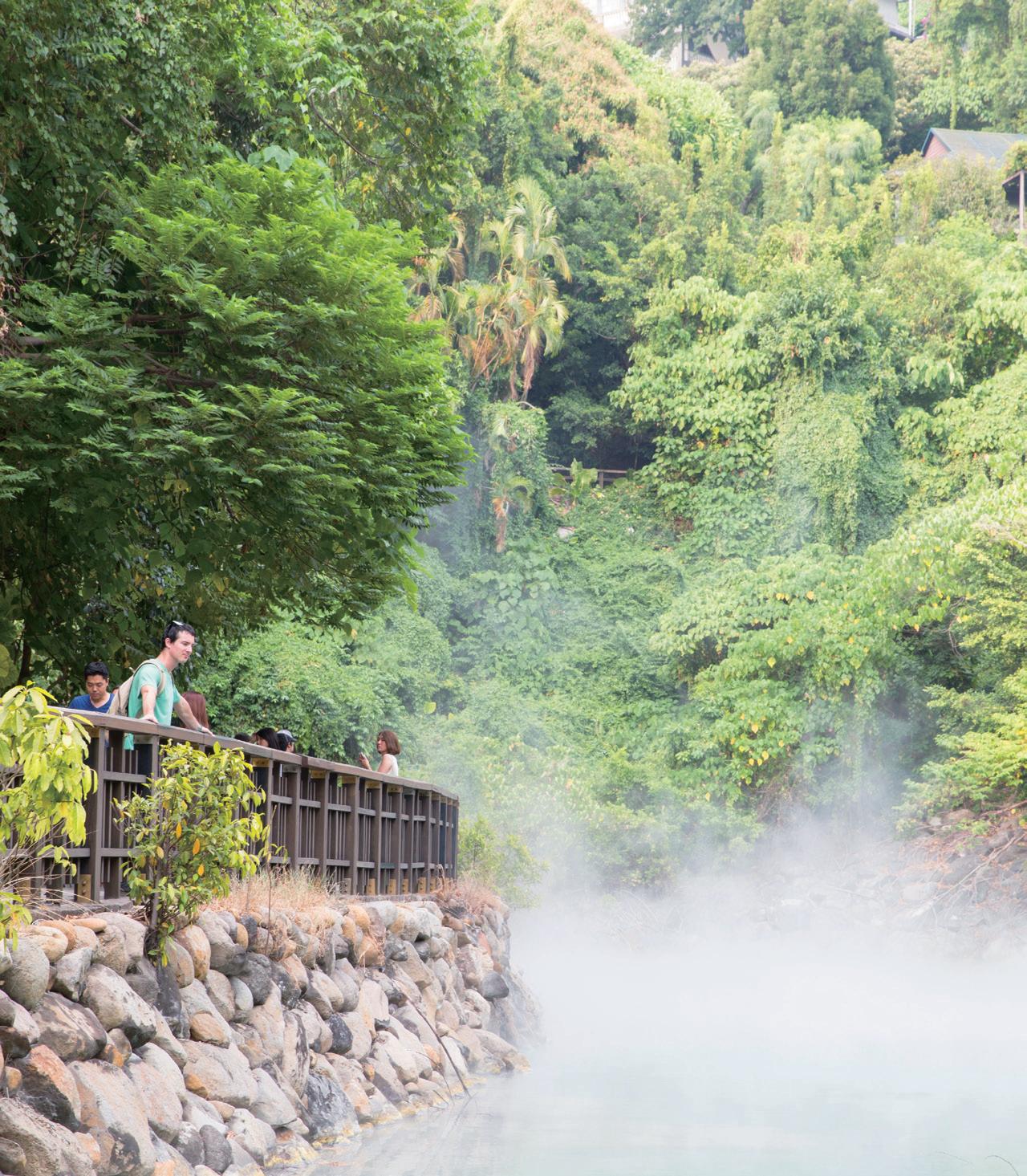




Dear Traveler,
We welcome you for a voyage of discovery of the comfortably breezy Taiwan of late autumn!
In our trio of feature articles this issue, we take you to a city not physically distant from Taipei but a world apart in terms of character. Keelung is a picturesquely situated port city on the north/northeast coast that is fast shedding its long-held reputation as a rugged and rainy seaport in a transformation that is making it a favored tourist destination for both local and international tourists.
In our main article, the theme is “dawn swimming, ghost parades, and fire fishing in Taiwan’s most underrated city.” Each of these attractions is unique – try to guess what each entails before diving into the article. Three out of three makes you a Keelung-culture expert!
In a second article, you’re headed out to sea on a guided boat tour to the bobbing rocky landmass called Keelung Islet. A 20-minute cruise over 5 kilometers of “deep blue” brings you to an isolated place featuring two scenic trails, cave-dwelling gods, and a strikingly painted lighthouse. Visitor numbers are strictly limited, so don’t miss out!
Keelung is a small city with a “big rep for ‘small eats’” –iconic snack foods. In our third article, we take you to the best sellers of three beloved local delicacies: jigula (a type of charcoal-grilled fish cake), pork liver sausage, and the self-promotingly named “nutritious sandwich.”
For our regular City Walks article, we’re zipping downisland to the sunny city of Taichung, located toward the island’s center on the west coast. You’ll be learning what makes this city tick, launching from its heart, the impressive old railway station/new railway station complex. Taichung’s core is “filled with heritage charms, big modern cultural facilities, and open green spaces aplenty, plus comparatively few high buildings & low people/vehicle density.”
Back up in Taipei – Good Food and Expert Talk . In the former, find out “where it gets hot in winter.” The cool season is hot-pot season, and you’ll be dining at three of Taipei’s premier specialist establishments, sitting down to the “mutton-rich flavors” of one, the “beefy indulgence” of another, and the “fiery Sichuan spiciness” of the third. In the latter, get set for this year’s Open House Taipei, part of the Open House Worldwide network.
Enjoy our beautiful island home!
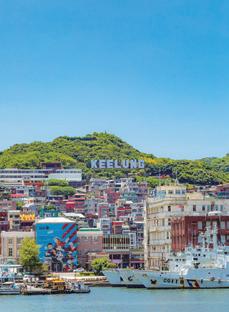
台灣觀光雙月刊
Travel in Taiwan
The official bimonthly English magazine of the Taiwan Tourism Administration (Advertisement) NOVEMBER/DECEMBER, 2025 Tourism Administration, MOTC First published Jan./Feb. 2004 ISSN: 18177964 GPN: 2009305475 Price: NT$200
中華郵政台北雜字第1286號執照登記為雜誌交寄 Copyright @ 2025 Tourism Administration. All rights reserved. Reproduction in any form without written permission is prohibited.
MAGAZINE IS SOLD AT:
1. Wu-Nan Culture Plaza, No. 6, Zhongshan Rd., Central Dist., Taichung City 40043 886-4-2226-0330 http://www.wunanbooks.com.tw/
2. National Bookstore, 1F., No. 209, Songjiang Rd., Zhongshan Dist., Taipei City 10485 886-2-2518-0207 http://www.govbooks.com.tw/
PUBLISHER
Taiwan Tourism Administration
EDITING CONSULTANT
T. C. Chou
PUBLISHING ORGANIZATION
Taiwan Tourism Administration, Ministry of Transportation and Communications
CONTACT
International Division, Taiwan Tourism Administration Add: 9F, 290 Zhongxiao E. Rd., Sec. 4, Taipei City, 10694, Taiwan
Tel: 886-2-2349-1500 Fax: 886-2-2771-7036
E-mail: tad@tad.gov.tw Website: http://taiwan.net.tw
PRODUCER
Vision Creative Marketing & Media Co.
ADDRESS
1F, No. 5, Aly. 20, Ln. 265, Sec. 4, Xinyi Rd., Taipei City 10681, Taiwan
Tel: 886-2-2325-2323 Fax: 886-2-2701-5531
editor@v-media.com.tw
GENERAL MANAGER
David Hu
This magazine is printed on FSC® COC certified paper. Any product with the FSC® logo on it comes from a forest that has been responsibly maintained and harvested in a sustainable manner.
ABROAD
Offices of the Taiwan Tourism Administration in Beijing, Shanghai, Hong Kong, Singapore, Bangkok, Ho Chi Minh City, Kuala Lumpur, Seoul, San Francisco, New York, Los Angeles, Frankfurt, and London. Overseas Offices of the Ministry of Economic Affairs; Overseas Offices of the Central News Agency; EVA Air, and other selected international airlines; selected travel agencies in Asia, North America, and Europe; and other organizations.
IN TAIWAN
Tourism Administration Visitor Center; Tourism Administration; Taiwan Visitors Association; foreign representative offices in Taiwan; Tourism Administration service counters at Taiwan
Taoyuan Int’l Airport and Kaohsiung Int’l Airport; major tourist hotels; Taipei World Trade Center; VIP lounges of international airlines; major tourist spots in Taipei; visitor centers of cities and counties around Taiwan; offices of national scenic area administrations; public libraries
EDITOR IN CHIEF
Johannes Twellmann
ENGLISH EDITOR
Rick Charette
DIRECTOR OF PLANNING & EDITING DEPT
Joe Lee
MANAGING EDITOR
Anna Li
EDITORS
Masako Takada, Lynn Chang
CONTRIBUTORS
Ami Barnes, Rick Charette, Han Cheung, Jenna Lynn Cody
PHOTOGRAPHERS
Chen Cheng-kuo, Ray Chang
DESIGNERS
Ian Tsai , Hsieh Yun-jhen
ADMINISTRATIVE DEPT
Lily Wan, Hui-chun Tsai, Xiou Mieng Jiang
This magazine was printed with soy ink. Soy ink is said to be more environmentally friendly than petroleum-based ink and to make it easier to recycle paper.
ONLINE
Read Travel in Taiwan online at www.travelintaiwan.net. Find back issues (PDF version) on the publication platform issuu at issuu.com/travelintaiwan



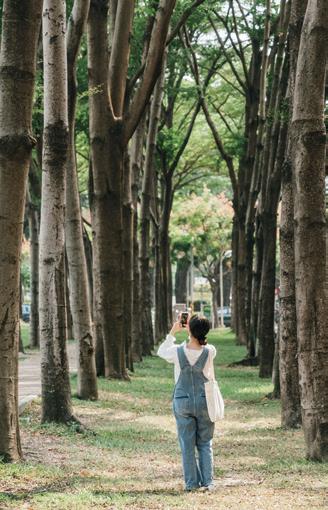





TAINAN CITY 1
Nov 15–16
KUNSHEN WANGYE’S SALT FOR PEACE FESTIVAL
鯤鯓王平安鹽祭
This festival, a unique cultural and religious event in Tainan, celebrates local folk beliefs and the historical salt industry of southern Taiwan. Centered around the Nankunshen Daitian Temple, it honors the “Wangye” deities, powerful emissaries from Heaven believed to protect the people against evil and disaster. The festival also highlights salt’s purifying properties. The main event is a procession in which sea salt is collected from the Jingzaijiao Tile-paved Salt Fields and brought to the temple to be blessed by the deities.
www.swcoast-nsa.gov.tw
TAITUNG COUNTY 2
Dec 13–14
TAIWAN PASIWALI FESTIVAL
The Taiwan Pasiwali Festival is an annual event celebrating Taiwan’s diverse indigenous cultures. Held at Taitung Forest Park in Taitung City, it is a showcase of traditional and contemporary music, dance, and art. The festival’s name, “Pasiwali,” is an Amis word for “forward,” symbolizing the preservation and promotion of indigenous culture. The event features performances by indigenous singers and groups, a cultural market with crafts and food, and workshops on traditional skills.
taiwanpasiwalifestival.com
NEW TAIPEI CITY 3
Nov 14 – Dec 28
CHRISTMASLAND IN NEW TAIPEI CITY
新北歡樂耶誕城
This is a major holiday event known for its elaborate light displays, massive Christmas tree, and festive activities, including stage performances and a Christmas Market. Held annually, it transforms New Taipei City’s Banqiao District into a bustling winter wonderland. One of the more unusual activities is the Christmas Marathon Relay Race on December 7, a team event during which participants will run through the festively decorated streets, many dressed in red attire and wearing Santa hats. newtaipei.travel
This multi-hour countdown extravaganza, held at Taipei City Hall Square, features live performances by local and international artists, leading up to the famous post-countdown Taipei 101 fireworks display. Beyond the main concert, festivities also include pre-party activities and themed light installations throughout the Xinyi District. Drawing a massive crowd, the jamboree has a lively atmosphere with a festive mood that lasts until long after midnight (Taipei Metro trains run throughout the night to accommodate nightowl revelers).
english.tpedoit.gov.taipei
5
CHIAYI COUNTY Dec 19 – Jan 1
嘉義市國際管樂節
A premier music happening in Taiwan, this festival features marching bands from around the world. It has cemented Chiayi’s reputation as a “city of wind music.” The festival features a variety of indoor and outdoor performances, including a marching parade and large-scale evening concerts. This year’s edition will be especially notable, as the festival will be combined with the “320+1 Chiayi City Expo,” running from December 12 to 28, to celebrate the city’s 321st anniversary. www.chiayiband.com.tw
The Longci Light Festival is a popular outdoor light festival held annually in Longci District, one of the least-populated districts of Tainan City. It’s known for transforming the unique hilly terrain of Huxingshan (“Tiger-Shape Mountain”) Park into a magical world of art and light. The festival emphasizes the connection between art, nature, and the local community, with many installations, inspired by local stories and legends, created in collaborations between artists and residents. www.facebook.com/longcilightfestival







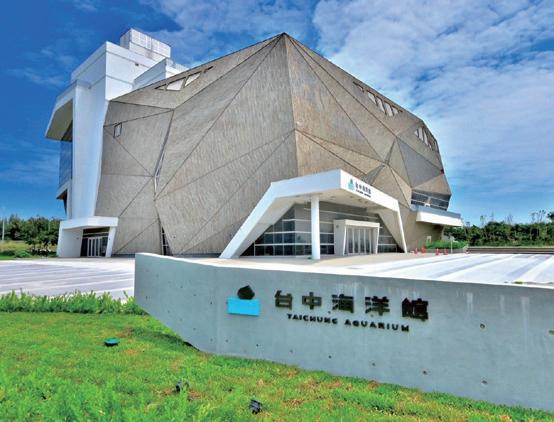
The first phase of the National Railway Museum in Taipei opened this summer, transforming the historic Taipei Railway Workshop into a new cultural landmark. Located just north of Songshan Cultural and Creative Park, the museum preserves and showcases Taiwan’s rich railway history. Visitors can explore a variety of restored buildings and permanent exhibitions, including a major highlight: a large hall with 24 retired locomotives on display. Railway lovers get a close-up look at the trains and the industrial culture that shaped Taiwan’s transportation. www.nrm.gov.tw

The Taichung Aquarium officially opened in August, becoming a new tourist attraction in the coastal district of Qingshui. Its design is unique, with a fully open concept that lets visitors get closer to marine life than traditional aquarium exhibits allow. Interactive digital displays and projection mapping have also been incorporated to create an immersive, technologically enhanced experience. Guests are taken on a journey from the
rivers of Taichung to the world’s oceans, with key highlights including an immersive ocean tank, an open-display penguin area, and Taiwan’s first indoor wetlandexperience zone. This new facility is expected to become a major draw for tourism, connecting nearby attractions like the Wuqi Fishing Port and Gaomei Wetlands. tcaqua.com.tw
The Smart Selfie System at Hualien County’s Liyu Lake is an innovative tourist service that lets you take high-quality photos difficult to take with a regular smartphone. Using a remote-controlled 4K camera, it captures wide-angle shots of visitors on the Tannan Pier with the stunning lake and mountain scenery in the background. To use the system, just scan a QR code, select a shot angle, and follow the voice prompts. Afterwards, you can add special frames and download or share your photo on social media. More of these systems are planned for other scenic spots in the East Longitudinal Valley National Scenic Area.
This new and unique attraction in Chiayi County, southern Taiwan, is an expansive theme park designed to look like a magical European castle, focusing on artistic sculptures and an immersive, cocoa-themed experience. It was brought to life by a local Chiayi artist and sculptor, Mao Rong-hai, who also serves as the chairman and the lead artist behind the project. More than just an architectural marvel, the castle aims to be a comprehensive tourist destination, offering visitors a chance to explore a fairy-tale-like setting while learning about and enjoying chocolate-related activities. www.otherworld.com.tw

This historical dormitory complex, located just to the east of the Kaohsiung National Stadium (Kaohsiung Metro World Games Station), offers visitors a unique glimpse into Taiwan’s past. Originally built by the Japanese Imperial Navy to house personnel from its Sixth Fuel Factory, as well as military personnel and their families. After being designated a municipal historical site in 2014, a major restoration project was initiated, culminating in its official public opening in August this year. The cultural heritage space is open to visitors from Tuesday to Sunday (free admission) to explore its preserved architecture and enjoy various art exhibitions and cultural events.

Since October, all foreign visitors to Taiwan have been required to complete an online Taiwan Arrival Card (TWAC) before entering the country. This new digital system has replaced the traditional paper forms to streamline immigration clearance and reduce wait times at border entry points. Travelers can fill out the form online within three days of their arrival, and the system includes a feature that can automatically extract passport information from a photo to make the process faster.

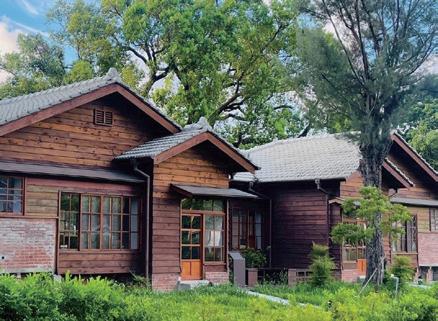
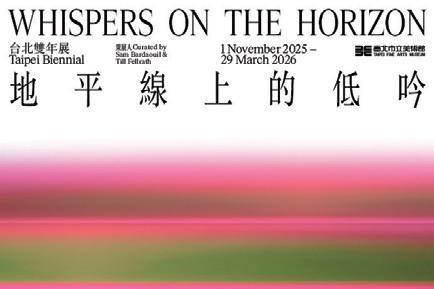
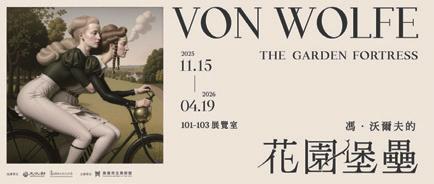

1
Exhibition
TAIPEI BIENNIAL – WHISPERS ON THE HORIZON
台北雙年展 – 地平線上的低吟
Nov 1 – Mar 29
Taipei Fine Arts Museum ( Taipei City )
Curated by Sam Bardaouil and Till Fellrath, the 14th edition of the Taipei Biennial, titled Whispers on the Horizon, brings together 54 artists from 35 cities worldwide, with nearly half of the participants born after 1984. The exhibition features 33 newly commissioned works and other site-specific installations that explore the complex theme of “yearning” as it relates to Taiwan’s history and universal human emotions. It draws inspiration from specific literary and cinematic objects, such as a puppet, a diary, and a bicycle, and creates a dialogue between contemporary works and historical Taiwanese paintings from the Taipei Fine Arts Museum’s collection.
www.taipeibiennial.org
Exhibition 2
VON WOLFE: THE GARDEN FORTRESS
沃爾夫:花園堡壘
Nov 15 – Apr 19
Kaohsiung Museum of Fine Arts ( Kaohsiung City )
This is the first retrospective in Asia for British artist Wolfe von Lenkiewicz, featuring over 60 artworks created between 2009 and 2025. His paintings are distinguished by an innovative approach that fuses traditional oil painting with compositions developed using artificial intelligence. His work often deconstructs and reassembles elements from historical masterpieces, creating new, complex narratives that explore themes of power, originality, and the evolution of art in the digital age.
www.kmfa.gov.tw
Music 3
FIREBALL FESTIVAL
火球祭
Nov 22 – 23
Rakuten Taoyuan Baseball Stadium ( Taoyuan City )
This festival, staged annually in Taoyuan, is one of Taiwan’s most electrifying music events. It was launched in 2017 by acclaimed punk band Fire EX. Held at the Rakuten Taoyuan Baseball Stadium, the two-day festival gives music fans an immersive experience that blends rock, punk, metal, hiphop, and indie music. Known for its high-energy performances, interactive stage designs, and family-friendly atmosphere, the festival attracts both local and international artists. www.instagram.com/fireball_fest


Musical 4
CHARLIE AND THE CHOCOLATE FACTORY
巧克力冒險工廠
Dec 17 – 28 Taipei Music Center Performance Hall
Jan 2 – 4 National Kaohsiung Center for the Arts ( Weiwuying )
Based on Roald Dahl’s beloved 1964 novel of the same name, this musical first premiered in London’s West End in 2013 before moving to Broadway in 2017. The production is known for its inventive stage design, which uses projections, puppetry, and magical effects to bring Willy Wonka’s eccentric world to life. The Taiwan premiere, produced by Broadway International Group, is a special “upgraded” version tailored for Asian audiences, offering an immersive fantasy experience for all ages. www.tmc.taipei www.npac-weiwuying.org
Theater 5 5 6 4
BÉRÉNICE
貝芮妮絲
Nov 14–16
National Taichung Theater ( Taichung City )
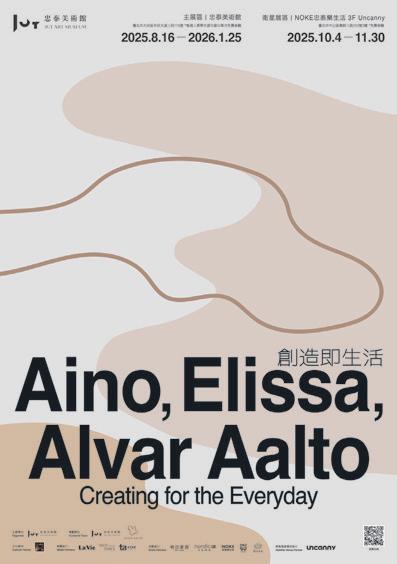
Exhibition 6
AINO, ELISSA, ALVAR AALTO – CREATING FOR THE EVERYDAY 創造即生活
Aug 16 – Jan 25
Bérénice is a production of a classic French play by Jean Racine, reimagined by influential Italian director Romeo Castellucci. The play, a masterpiece of 17 th -century French tragedy, tells the story of the impossible love between the Roman Emperor Titus and the Queen of Palestine, Bérénice, with the former forced to choose between love and imperial duty. This particular adaptation is notable for starring legendary French actress Isabelle Huppert, whose powerful performance is central to Castellucci’s abstract and visually striking style. The show is recognized as a major international event, bridging a historical literary work with a modern, avant-garde theatrical vision. www.npac-ntt.org
JUT Art Museum ( Taipei City )
This is the first large-scale retrospective in Taiwan on the renowned Finnish architect and designer Alvar Aalto and his two wives, also architects, Aino and Elissa. The exhibition focuses on their collaborative partnership, showcasing a wide selection of original manuscripts, models, and furniture. It explores the deep connection between their architectural work and their daily lives, providing a comprehensive look at the creators’ unique approach to design. Through meticulous curation and modern exhibition techniques, the museum brings the artists’ creative journey to life. jam.jutfoundation.org.tw

Swimming, Ghost
Fire

A few years back, the harbor city of Keelung rebranded itself with a snappy new slogan: “A city full of .” Optimistically intended as an expression of limitless potential, jokers swiftly seized the opportunity to proffer witty suggestions for the missing word, most charitable among which was “rain.” Still, the last laugh is on those snarkers, because as you’ll discover over the following pages, there’s so much more to this rainy port city than inclement weather.
Less than an hour from central Taipei City by train, Keelung occupies a curious position on the Taiwan travel map, being simultaneously the literal first port of call for the small subset of travelers who arrive in north Taiwan by cruise ship and an afterthought for almost everyone else. Weatherworn and hardy, it bears a protective armor of sea air rust and port-city grit, but beneath this rough-around-the-edges exterior is a proud maritime community with hardworking people, fine seafood, a rich history, top-notch coffee, ghosts, colorful markets, and even more colorful traditions. Whether you surrender to its summer siren song of cool, clear waters, or the deliciously moody embrace of winter’s neon-splashed puddles, condensation-fugged windows, and fragrant plumes of steam – Keelung, it turns out, truly is a city full of

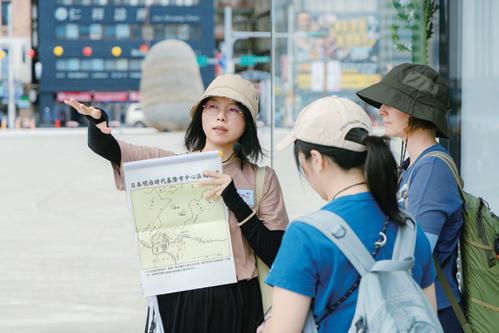
One group that definitely knows how fascinating Keelung can be is the team at Keelung for a Walk . This locally owned and operated tour company has been offering English and Mandarin tours of Keelung’s secret spots for the past decade, to introduce people to the delights of a city often maligned by outsiders as perpetually wet and dreary. The organization runs four regular tours as well as seasonal and rotating monthly offerings covering esoteric topics that even lifelong Keelung residents may know little about. For this edition of Travel in Taiwan, we joined two of these tours, the Cultural Tour and the Ghost Festival Tour (offered during the annual Ghost Festival period).
We met up with Ilun, a Keelung native and one of the company’s guides, in front of the historic Harbor Building just to the north of the railway station on the west side of the main harbor. Whipping out a map, she showed us how Keelung appeared, in the 17th century, to the Spanish settlers who were the first to survey the area (though not the first to live here; that distinction goes to the Basay Tribe of the Ketagalan indigenous people), a natural harbor sheltered between mountainous arms. Moving closer to the waterfront, she flipped through later maps, helping us trace how the landscape evolved, with wiggly inlets straightened, islands razed, contours inching incrementally closer to what we could see before us – a huge port that was once the most important ingress and egress point in all of Taiwan.
Over the next three hours, Ilun led us through the streets of her hometown, delivering a broad-ranging introduction to the diverse cultural influences that have shaped the city. Inside Chenghuang Temple , we met Keelung’s City God, and admired the generous offerings of cosmetics and jewelry left in high piles for his wife – pleas from those faithful





wishing to resolve domestic troubles. In a dingy backstreet, we heard tales about the American servicemen whose hunt for liquor, ladies, and late-night liveliness during rest and recuperation breaks from Vietnam postings spawned a whole industry (and a small cohort of dual-heritage babies). We paused briefly beside Kanziding Fish Market (location of Keelung for a Walk’s Night Market Tour), then skipped over railway tracks to explore an old bomb shelter now serving a secondary purpose as a residents’ shortcut.
Our cultural tour concluded at the Ren’ai Market . This gargantuan two-story covered shopping area spans an entire city block and attends to every conceivable need of daily life. On the ground floor is a wet market, where Ilun snagged us some Taiwanstyle tempura snacks (chewy fried fishpaste cakes), while the top floor is filled with eateries (the sushi is apparently excellent), cafés, and hair salons transported straight from the 1970s.
The second time we met was a few days later. Specifically, on the thirteenth day of the seventh lunar month – close to the zenith of the city’s annual Midsummer Ghost Month festivities – and we were there to observe the Dipper Lantern Parade. Ghost Month, or Ghost Festival, is an annual event spanning the entire seventh lunar month (Aug. 23 – Sept. 21 in 2025). It has roots in both Buddhism and Daoism, stretching back thousands of years to a time when appealing to gods and ghosts was the only recourse communities had for dealing with their anxieties.


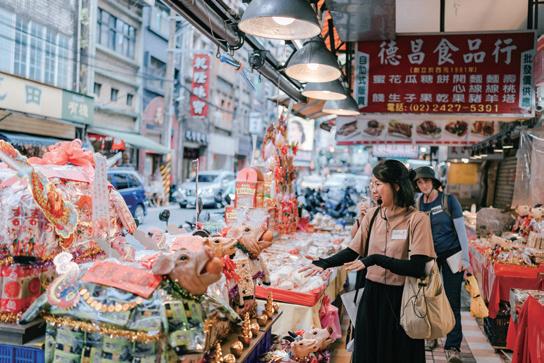
KEELUNG FOR A WALK | 雨都漫步
Keelung Memory Market: 1F, No. 25-22, Ln. 6, Liumingchuan Rd., Ren'ai Dist., Keelung City ( 雨都好室 : 基隆市仁愛區劉銘傳路 6 巷 25 之 22 號 1 樓 ) 0968-607-676 keelung-for-a-walk.com
On the first day of the month, the gates to the underworld open, and until they’re resealed on the 30 th , hungry ghosts are thought to maraud unseen through the realm of the living, bringing all kinds of misfortune. From unexplained ailments and nightmares to career stagnation and family discord, every ill is blamed on these lost souls, and to live among a Chinese-speaking community during this period is to endure a constant stream of well-meaning admonishments from elders. No swimming in streams, lakes, or oceans (water spirits will tug at your ankles as they vie to seize replacement souls). Don’t leave your washing hanging up at night (spectral fashionistas may see it as an invitation to snag some new swag). Never call them “ghosts” (the polite term is “good brothers” or “good sisters”). These aren’t just advised out of tradition. For many, the unease is genuine.
During this time, people sublimate their fear of the restless and improper dead roaming about in rituals and mass oblations – a practice known as pudu. Throughout Taiwan, communal altars in neighborhoods and outside office buildings groan under the weight of offerings put out to appease hungry spirits and maintain social harmony. Keelung, however, goes to extra lengths with its observances.



Gathered in Keelung Memory Market – a stall inside the Huilong Market, which has been turned into an exhibition space by Keelung for a Walk – we learned that the origins of Keelung’s oversized Ghost Month festivities trace back to the 1850s, when a particularly violent historical feud between competing groups of immigrants from the Quanzhou and Zhangzhou areas in China led to over 100 deaths.
To avoid escalating bloodshed, a pact was drawn up in 1855 limiting the factions to settling their differences by battling with religious performances. Rival clans took turns attending to arrangements, and – until the subduing effect of World War II led to it being scaled back – the event continually grew in size and extravagance as hosts competed to outdo the activities of the year before. Today’s visitors, however, will likely find it hard to imagine how the month-long calendar of events could possibly have been any grander.
The Dipper Lantern Parade is one of two processions that snake through the city’s streets each year (the second, larger procession is held the following evening and culminates in the release of water lanterns at Badouzi Tourist Fishing Harbor). If you’ve ever experienced the thrill

of being a child at a carnival, you’ll recognize the energy. Tightly coiled excitement pulses through the air, all bright lights and clashing, off-kilter beats. Electrified floats adorned with flashing lights and animatronic contraptions blare pounding electro-pop. Beiguan orchestras march on foot, their suona horns reedy and ear-splitting en masse, while the sounds emanating from huge gongs reverberate through your chest. Around this chaos, there’s much shouting from elderly gentlemen in the guise of important organizing, shrill whistles, and gesturing from harried police trying to manage the crowds. It is gloriously overstimulating.
Ilun led us through and around the parade, dipping in to see the whole thing kicked off with firecrackers, and pausing
to watch a Beiguan battle between rivaling clans (it was the gentlest battle I’ve ever watched – two teams of horn-blowing grandpas in straw trilbies and sunglasses faced off against each other). The day’s festivities concluded in Qing’an Temple, where huge lanterns were carried inside and placed beside an altar dedicated to the goddess Mazu. The lanterns – ornate wooden contraptions, many of which are almost as old as the parade itself – are so heavy and unwieldy that most need to be broken into three pieces to be transported through the courtyard and over the temple’s threshold. Watching the teams work together to maneuver their clans’ ancient lanterns into place, it struck me how impressive it was that a celebration so full of beauty and teamwork had been born from such fractious beginnings.



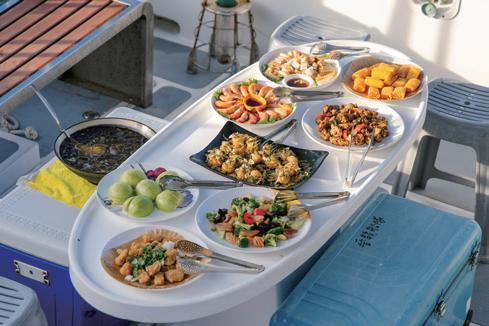
Given Keelung’s intimate relationship with the ocean, it’s hardly surprising that fishing is a keystone of the local economy. Harbors big and small break up the coastline, fleets of lantern-rigged vessels stream out at dusk and return, catch-laden, in the wee hours, and several companies offer excursions for visitors keen to sample the fruitful waters of Keelung’s piscine scene. We booked a sunset sailing with Jinlong Yacht Club (see next article for a trip to Keelung Islet with the same company), which, for NT$1,800 per person, took us on a combined fishing expedition and exploration of the region’s sulfuric fire fishing heritage. (Fire fishing tours
are available June to September, while fishing-only tours are available April through October. Equipment provided.)
Departing Badouzi Tourist Fishing Harbor at 5:30pm, we were treated to an onboard seafood feast before heading in search of our fishing grounds – around us, the day’s dying sun painting bold pinks onto the clouds and setting the mountain town of Jiufen aglitter. The waves were noticeably stronger 15 minutes out, so once the engines were cut, a para-anchor was deployed, letting the prow drift windwards to minimize rolling, and a concentrated hush fell over the group. The gentle swooshing of waves was punctuated only by whirring fishing reels and the occasional high-pitched pips of land-bound terns – blurred smudges of white against the gathering murk.
After 10 minutes with no bites, the skipper began giving depth updates using his radar, “They’re there. Twenty-five meters down, swimming back and forth.” Twice, an excitable cry went up, “I’ve got something!” But after careful reeling, it was discovered – cue much mirth – all that had been hooked was another line. Depending on the season, you might catch




squid, mackerel scad, or Pacific cutlassfish. However, someone had clearly neglected to entreat Mazu (the preferred deity of seafaring types) for assistance, because when the time came to set off for the fire fishing demonstration, not a single fish had been netted.
Heading northwards, we sailed around the Yehliu Geopark peninsula to the sheltered bay just south of Jinshan town. In summer, these shallow waters attract schools of Japanese sardinella, and for generations the region’s anglers have employed a visually spectacular technique that involves luring phototactic fish with fire.
As with many traditions, the origins are somewhat nebulous. Perhaps indigenous fisherfolk taught the technique to Han settlers, or maybe the incomers brought it with them. Even the English name, sulfuric fire fishing, seems to have morphed in translation, since the fire is actually generated by igniting acetylene gas (created by adding water to calcium carbide), not sulfur. Leaving such quibbles aside, this historic, only-used-in-Taiwan technique was fascinating to observe.
First, a thin, sibilant whoosh went up, then a heavy whump, as if someone had walloped a mattress, and a meter-high flame blazed into life. At first, all I saw was a dazzling pool of light illuminating the shifting water, then suddenly, tiny silver fish were breaching the surface, hurling themselves at the midnight sun with reckless abandon. On deck, the fire warden swept his torch port-side, guiding the net-dippers who were awaiting the perfect moment to thrust their unwieldy two-man contraption into the shoal. Before they had time to haul the catch onboard, the flame blinked out, plunging the scene into a darkness even deeper than before. It was a hypnotic sight.
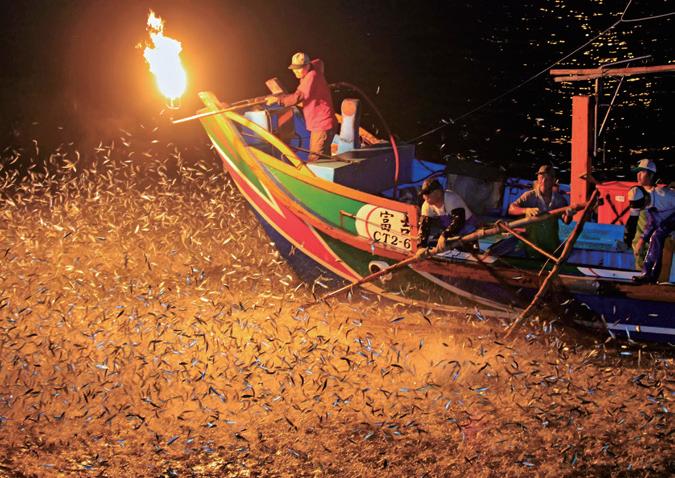

We watched, following at a distance, for an hour, and when it was time to head back to dry land I was left feeling strangely, unexpectedly moved. There is something humbling about witnessing ancestral ingenuity from a time when we were perhaps slightly better at preserving the ecological balance.
JIN LONG YACHT | 晉龍遊艇船隊
Badouzi Tourist Fishing Harbor; No. 211, Beining Rd., Zhongshan District, Keelung City ( 八斗子漁港 ; 基隆市中正區北寧路 211 號 ) 0918-373-560, 0965-829-560 jinlong-yacht.com.tw

If you’re hoping to get a sense of how Keelung locals spend their free time, look no further than Waimushan Lovers Lake Coastal Boulevard in the Waimushan Seaside Scenic Area. Extending east to Dawulun White Sand Beach and west to Waimushan Fishing Harbor and Haixing Swimming Pool, this 3-kilometer stretch of coastal road is where Keelung residents come to stroll, swim, run, snorkel, paddleboard, sing, sip coffee, and walk their pet turtles (no, really).
To get there, take a taxi or the No. 310 bus from Keelung Bus Station and commence your wanderings at Dawulun’s golden-sand beach. A family favorite, lifeguards patrol this horn-shaped cove on weekends, and a healthy ecosystem of parasol rentals, pay-to-shower places, and snack shops caters to the crowds. Alternatively, sand shunners could kickstart their coastal adventures with a jaunt up Haixing Trail. Steps climb from the beach to Lovers Lake and the banyanwrapped stone edifice of Dawulun Fort . The imposing hilltop compound – one of several standing sentinel over
Keelung – dates to the 1820s and was expanded by several subsequent administrations before settling into its current role as a backdrop for hiking photos.
Back on the coastal road, a wide paved promenade skirts the water’s edge. Anglers – human and avian – perch on wave-dashed rocks waiting for luck to bite, and on weekends, the occupants of roadside carparks look like they’ve spilled straight from the pages of a Taiwan-coded van life brochure – there are portable cinemas, karaoke bars, and compact kitchens replete with fridge and rice cooker.
Haixing Swimming Pool sits at the eastern end of Lovers Lake Coastal Boulevard. On a separate recent visit to this free facility, I arrived early (or so I thought) at 7am, only to be greeted by the vanguard dawn dippers emerging after completing their swim, saltwater footprints marking their procession from shore to shower block. Midweek, there wasn’t much variation in swimmer demographics. The vast majority seemed to belong to the retiree class, but while the



age range remained consistent, there was a stark contrast between the unofficial uniform for men and women. The former all seemed to be rocking nothing but goggles and sun-faded budgie smugglers, while the latter were clad head-to-toe – literally – in sunhats, facekinis, full-body wetsuits, and swim shoes. Many also toted open-water tow floats, especially those venturing further out.
Three zones help separate the small fry from the selkies. There’s an enclosed concrete pool for learners and kids, an intermediate area connected to the ocean at one end, and – beyond a string of warning buoys – open water where swimmers bust out impressive 1,000-meter laps around a small skerry. Beneath the waves, snorkelers will find themselves eye-to-eye with all kinds of weird and wonderful denizens of the not-so-deep. Bright blue neon damselfish and the zebra-striped Indo-Pacific sergeants are all but guaranteed sightings. A glance at the spot on the citizen science app, iNaturalist, shows a rich underwater world.
Admittedly, with the Hsieh-Ho Power Plant’s smokestacks and a pair of squat, cylindrical oil tanks looming over the pool, it might not seem the most salubrious spot for a soak, but don’t worry, when you stop focusing on all that concrete your attention drifts to the rippling dance of light on the surface, the way waves lift and carry your body, the sun-bronzed, watersculpted glisten of the regulars’ muscles, the sweet ocean scent clinging to your skin, and the rhythmic white-noise dialogue between sea and shore.

On the eastern lip of Keelung Port lies Zhengbin Fishing Harbor, another of the city’s hangout spots – this one much better known among out-of-towners. In the past decade, the harbor and adjacent Heping Island have cemented their roles on the Keelung travel itinerary, the fishing port as a place for photo check-ins thanks to the rainbow houses beautifying the waterfront’s southern edge, and the island as a quiet spot for admiring the scenery and taking a dip.
Walk up Zhengbin Road, away from the colorful row of houses, across Bachimen channel, and you’ll soon find yourself on the rich historical palimpsest that is Heping Island. Embedded literally and figuratively in the land are traces of habitation spanning millennia. Archaeological digs have unearthed prehistoric stone tools and 300-year-old glass earrings, while a congregation of long-deceased Spanish missionaries has lain entombed beneath a carpark for years. The tiny Fanzi Cave holds memories of Dutch graffiti dating to the 1660s, and along the shore sit odd formations christened “tatami mat rocks” by Japanese Ryukyuan fishermen who drifted here chasing abundant catches. Even the island’s present-day name, meaning “peace,” contains a historical nugget. Formerly known as Sheliao Island, it was renamed following a massacre – part of the wave of atrocities that swept the land in the wake of the bloody 228 Incident in 1947 that saw shipyard workers and fishermen killed and disappeared. (If you’re interested in learning more, Keelung for a Walk also conducts tours of Heping Island.)

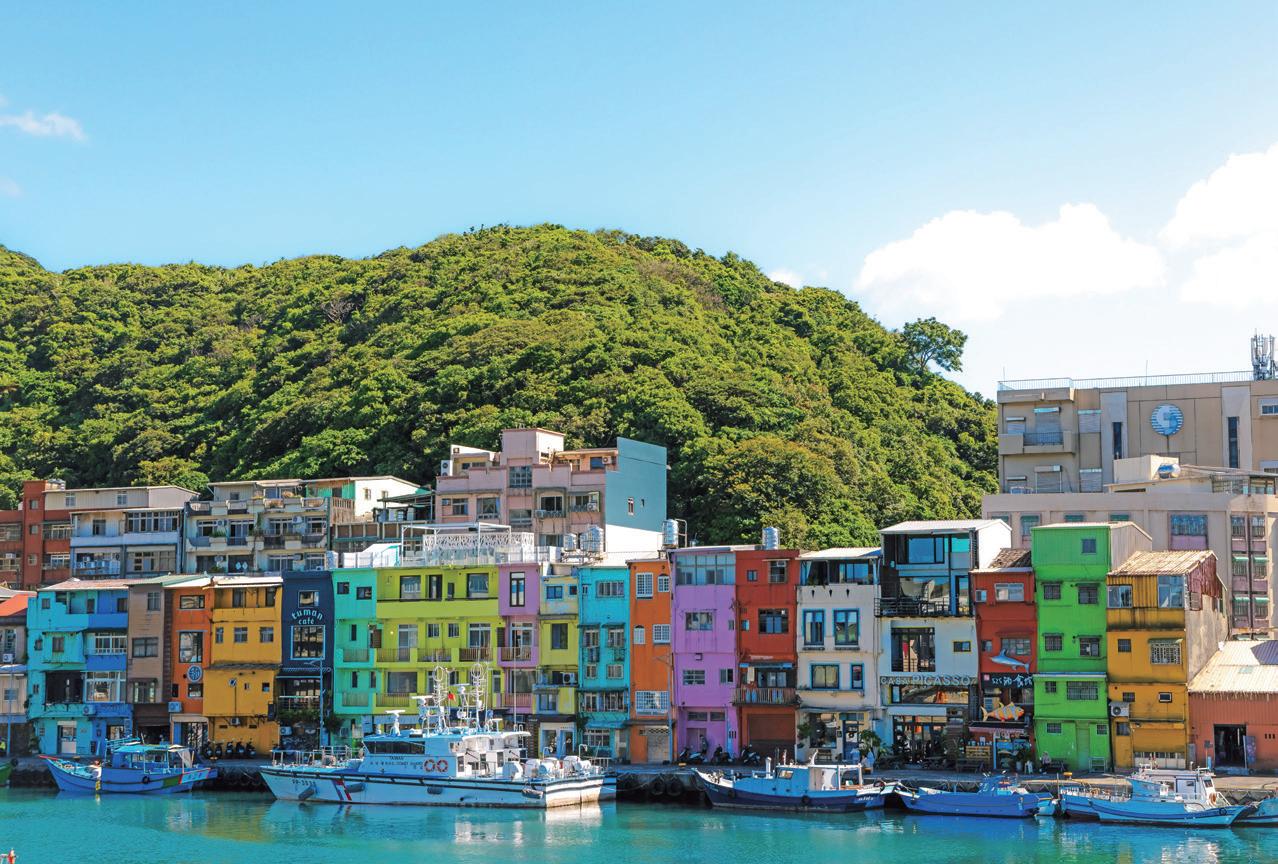



A 10-minute stroll from Heping Bridge brings you to the gates of Heping Island Geopark (NT$120 entry for adults). The real draw here is the trio of ocean-fed pools – main, pet, and paddling – that rise and fall with the waves, reaching depths of up to 2.5 meters at high tide. There’s also an artificial beach with a stream where kids can dig and work on their sand-based architectural prowess. The pools are open year-round, and hardy swimmers brave the waters even in the winter, though with February’s water temperatures hovering around 18°C, my UK family members would scoff at calling them hardy.
As for practicalities, the dress code seems looser than that of normal Taiwan swimming pools. There’s no mandatory hatwearing policy, and you are able to wear T-shirts to keep your skin protected from the sun. That said, water shoes are required for entry to the pools, and although this isn’t strictly enforced, trust me – barnacle-encrusted concrete and tender toes should never meet. The bright changing rooms offer 3-minute cold showers for NT$10 (hot water costs extra), while the visitor center rents everything from lockers to beach umbrellas and even a beach-going wheelchair.
If you haven’t brought your swimwear, not to worry, there’s still plenty to enjoy. Above the airy visitor center’s gift shop and exhibition space are a couple of cafés. My pick is Love Pin , which playfully incorporates maritime themes and ingredients into its menu of drinks and light snacks (think sea lettuce cheesecake and drinks made with agar and sea grapes). There’s also a short trail running around the headland with views overlooking the aforementioned Fanzi Cave and tatami mat rocks (aka tofu rocks), and if you visit between May and September, you can witness nature’s artwork by joining a tour of Alabao Bay’s weird and wonderful rock formations.
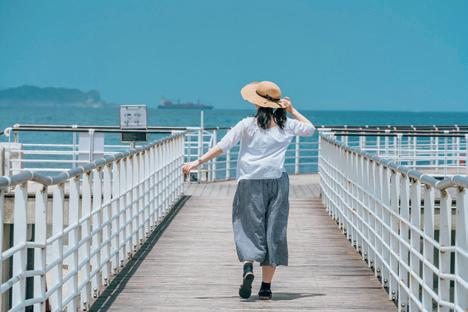
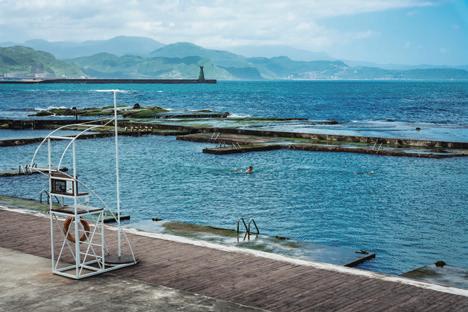
ENGLISH AND CHINESE
228 Incident | 二二八事件
Alabao Bay | 阿拉寶灣
Bachimen | 八尺門
Badouzi Tourist Fishing Harbor | 八斗子觀光漁港
Basay Tribe | 巴賽族
beiguan | 北管
Chenghuang Temple | 城隍廟
Dawulun Fort | 大武崙砲台
Dawulun White Sand Beach | 大武崙白沙灘
Dipper Lantern Parade | 迎斗燈遶境
Fanzi Cave | 蕃字洞
Ghost Month | 鬼月
Haixing Swimming Pool | 海興游泳池
Haixing Trail | 海興步道
Harbor Building | 海港大樓
Heping Bridge | 和平橋
Heping Island (Geopark) | 和平島 ( 地質公園 )
Huilong Market | 惠隆市場
Jinshan | 金山
Jiufen | 九份
Kanziding Fish Market | 崁仔頂漁市
Keelung Memory Market | 雨都好室
Ketagalan Tribe | 凱達格蘭族
Love Pin | 樂品喜塘
pudu | 普度
Qing’an Temple | 慶安宮
Ren’ai Market | 仁愛市場
Sheliao Island | 社寮島
Waimushan Fishing Harbor | 外木山漁港

Waimushan Lovers Lake Coastal Boulevard | 外木山情人湖濱海大道
Waimushan Seaside Scenic Area | 外木山濱海風景區
Yehliu Geopark | 野柳地質公園
Zhengbin Fishing Harbor | 正濱漁港






Taitung is a little bit of paradise. Tucked away in Taiwan’s southeast corner behind the island’s thick central mountains wall, the region reminds international visitors of pristine Hawaii, or a southern sea island idyll. A place of palm shade, green mountains backdrop, and the neverending rhythm of Pacific Ocean breakers rolling ashore. There is a rich indigenous peoples' presence here, and the renowned tourist-friendly Beinan* Site, which reveals the world of prehistoric Taitung denizens, is fully qualified to become a UNESCO World Heritage Site.






Small, easy-paced Taitung City looks out over the mighty Pacific. This is the perfect destination for travelers who like to stay active and have a love for the outdoors. Grab a rental bike – they’re readily available – and cycle Taitung Forest Park by the Beinan River on the north side, seaside Seashore Park, Old Railway Bikeway cutting through the city, or along the low-vehicledensity local roads and highways.
Get in some lake swimming and kayaking at the forest park’s Flowing Lake . High-quality surfing is enjoyed just up the coast, around Dulan village. The area’s mountains are scenically trail-laced, and local tribes offer cultural-experience mountain hikes. And you can even get up to some professionalaccompanied paragliding and hot-air ballooning at the Luye Plateau , the latter around the annual international Taitung Hot Air Balloon Festival
If seeking LOHAS pleasures, explore the Zhiben Hot Springs resort area just south of the city, and in the city itself are such highlights as Taitung Railway Art Village, housed in Taitung’s former railway station and large surrounding complex of ancillary facilities. The art village features a railway museum, studios, bars, and eateries. TTStyle Wave House, Taiwan’s only indigenous-themed creative park, features handicraft shops, cafés, and eateries housed in stacked-up cargo containers.
The crown jewels in Taitung’s tourism-enticements tapestry, however, are the Beinan Site and two other attractions of national-level importance, which were birth as an offshoot, Beinan Archeological Park and the National Museum of Prehistory
















The Beinan site was discovered in 1980 during work on the new Taitung Railway Station, on the city’s northwest edge. Spanning the Austronesian diaspora’s Neolithic and Iron ages, this is the largest and most complete prehistoric settlement ever uncovered on Taiwan, dating to 3,000 BC. It spans 18ha, with thousands of slate coffins and approximately 20,000 items of jade, pottery, and stone tools discovered. Above-ground, monolithic stone pillars had been entered into the scientific record by an important Japanese anthropologist in the early 1900s.
Identified as a potential World Heritage Site by the Taiwan World Heritage Committee, this and other qualified Taiwan sites are awaiting official consideration (currently not possible, since Taiwan is not a member of UNESCO and the United Nations).
This was Taiwan’s first archeological park, opened in 1997, at the dig site. A section of the excavation work protected by a roof is open for public visit. English signage explains what you are looking at – masonry walls, stone ladders, slate coffins, stone mortars, hearths, underground foodstorage spaces, etc.
Elsewhere on the landscaped grounds, you can explore an exhibition hall showcasing prehistoric Beinan culture as well as reproductions of prehistoric straw and bamboo dwellings based on the evidence of the digs, along with representative traditional Taitung indigenous structures from historical times. And take in a sweeping view of the hill-base area from a high-point observation deck. Native low-altitude plants have been cultivated to help recreate the natural-environment look the residents would have been familiar with long ago.
This expansive museum on the city’s west edge, opened in 2002, is perhaps Taiwan’s premier location to learn specifically about the Beinan digs and about the ways and means of the island’s original peoples, from prehistoric into historic times. This is the main venue for Beinan excavation treasure preservation and display. Highlights include a mock-up of a dig site that you descend into along a glass-floor walkway, dioramas depicting prehistoric life, and a full-scale oceangoing canoe of intricate symbolic decoration specially created by master craftsmen from the Yami tribe of Taitung County’s offshore Orchid Island (Lanyu), a major tourist destination.
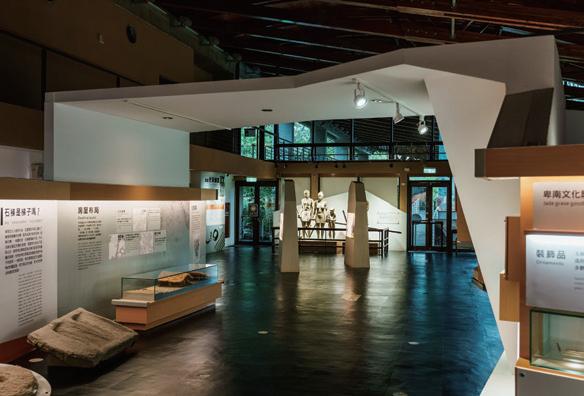

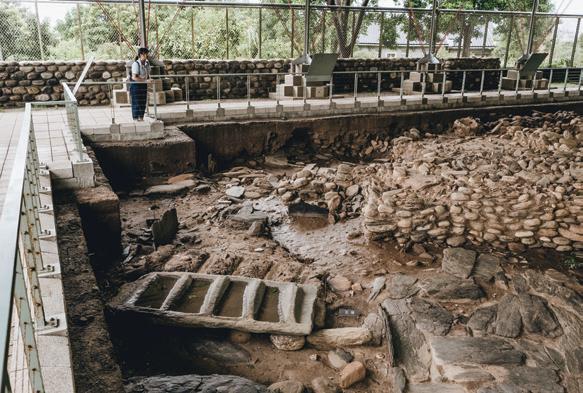
Public-visit section at dig site
BEINAN SITE PARK | 卑南遺址公園 (089) 233-466
No. 200, Wenhuagongyuan Rd., Nanwang Borough, Taitung City, Taitung County ( 台東縣台東市文化公園路 200 號 ) Tue-Sun 9am-5pm
NATIONAL MUSEUM OF PREHISTORY | 國立臺灣史前文化博物館 (089) 381-166
No. 1 Museum Rd., Fengtian Borough, Taitung City, Taitung County ( 台東縣台東市豐田里博物館路 1 號 ) Tue-Sun 9am-5pm www.nmp.gov.tw



Recently, from August 19 to 21, the Beinan Site × Cultural Resonance × 3 Days, 2 Nights special experiential camp promotion activity was held in Taitung City at Beinan Archeological Park, organized by the Taitung County Government Cultural Affairs Department and hosted by Daduway, a local enterprise dedicated to the promotion of indigenous identity, with a special focus on art and culturalcreative initiatives.
Individuals from around the world were invited to take part – from Australia, from Thailand, the Philippines, Vietnam, Pakistan, and Bangladesh in Asia, from the United States, Belize, and Peru in the Americas, from Palau and the Marshall Islands in Micronesia, and from Eswatini in Africa. The goal was to provide a deeper understanding of the Beinan Archaeological Site and to provide a personal experience of the prehistoric culture and Taitung’s contemporary indigenous cultures. The program included guided tours, lectures, DIY workshops, and cultural exchanges.
The English-speaking professional guides showed how ancient island denizens built their settlements. The lectures’ focus was exploration of the cultural networks of the Austronesian world, particularly through jade and pottery.

Hands-on pottery and stone tool drilling workshops enabled participants to experience the spirit of craftsmanship from five millennia ago. And through cross-cultural sharing and dialogue, cross-border cultural understanding and friendship were fostered.
The full activity was documented, with a multilingual promotional video created that is being used to promote Taiwan’s cultural-heritage international visibility as well as promote awareness of the importance of cultural-heritage preservation, helping to fulfill the vision of “globalizing local knowledge and internationalizing Taiwan’s cultural brand.”
With this first experiential camp such a stellar success, more such promotional initiatives are in the works for the future.
“It was a really nice and interesting experience. Thanks to the whole team for making it so pleasant and allowing us to learn more about the Beinan and Puyuma peoples, as well as Austronesian culture.”
Marycielo Valdez Sanchez (Peru)








Separated from its namesake city by just a short stretch of the deep blue, Keelung Islet offers a small but perfectly formed half-day trip for those looking to add island adventure to their city of Keelung exploration. Here, you’ll find scenic trails, cavedwelling gods, and a dramatically painted lighthouse — all without having to venture far from shore.

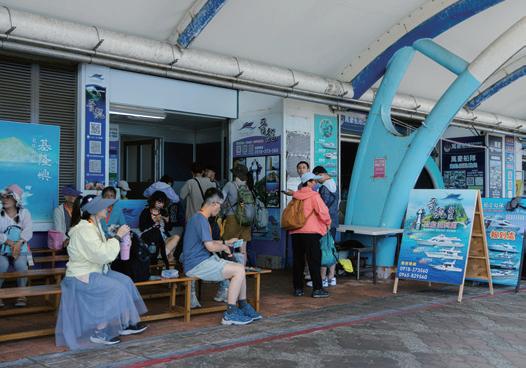
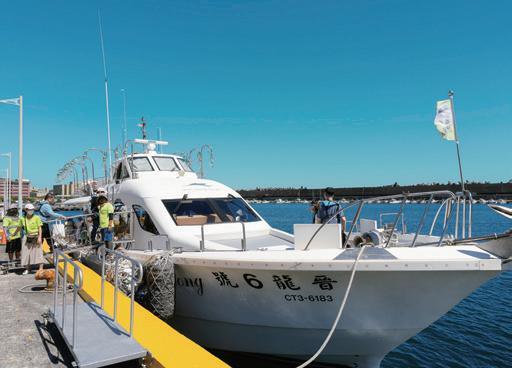
The adventure begins at Badouzi Tourist Fishing Harbor, from which a 20min boat ride whisks you across 5km of open water to the volcanic outpost of Keelung Islet. Open to the public between April and October, when ocean swell is minimal, the island receives not more than 1,200 visitors a day, although, unless you visit during weekends or peak flower seasons, you’re unlikely to find crowds.
Visiting the island involves leaving mainland Taiwan, meaning a landing permit is required, but don’t worry, this is not as onerous as it sounds. Several boat companies offer trips to the islet and, as far as I can tell, their services are all much of a muchness – so just pick one you like the look of and they’ll handle the application on your behalf. Trips can also be arranged through third-party platforms like KKday and Klook.
Essentially, there are three options to pick from. On a recent Travel in Taiwan visit, we booked a 4hr, 3-in1 trip through Jin Long Yacht Club ( jinlong-yacht. com.tw), which involved circumnavigating the island before disembarking to walk the coastal trail and climb to the lighthouse. This

trip costs NT$850 per person. There’s also a 2hr trip that skips the lighthouse trek and a 4.5hr version that adds a pootle along the mainland coast to view the Capybara Rock (formerly known as the Elephant Trunk Rock), close to Shen’ao Fishing Harbor. Some operators even offer special packages that include fishing outings similar to the one described on pages 16-17.
On the day of your trip, you just need to rock up 30min before departure with your ID, your most wind-proof form of sun protection (it’s gusty and exposed over there), comfortable walking shoes, and snacks to tide you over in case you get hungry. (The boat companies offer water, and there are toilets on the island, but nowhere to buy food, so you’ll need to go prepared.)
Arriving at the harbor at 9 o’clock sharp, we made our way to Jin Long Yacht Club’s counter to check in and receive our boarding passes, in the form of lanyards. There followed a safety talk and explanation of the morning’s plan (Mandarin only, as was the rest of the tour content), then we were each handed life jackets before being walked two-by-two in preschool crocodile formation past the coast guard station and on towards our vessel.
We steamed out of the port under clear skies, and our tour guide (a formidable orator with a broad depth of local knowledge) launched into a running commentary on everything in sight. Gaining distance, first Alabao Bay and Heping Island appeared to the northwest, alongside the red-and-white cranes of Keelung Port. Next, the triple smokestacks of the Hsieh-Ho Power Plant came into view, then, to the southeast, the town of Jiufen nestled into a mountain-fenced depression. Bitou Cape jutted out to sea further south, while the Yehliu Geopark peninsula did the same to the north, and much further out, hazy outlines of huge container ships marked the horizon.
It took about 20min to cross the gap, but before landing, we made a clockwise loop, sailing past Keelung Islet’s Mini Me, Little Keelung Islet , a couple of nostril-like sea caves, and a vantage point that our guide said made the rocky slopes resemble a woolly mammoth (personally, I thought it looked more like an anteater).
After disembarking, we set off to explore the island’s two trails, taking the coastal trail – shorter and easier of the two –as our warm-up. Extending for several hundred meters along
the islet’s eastern edge, the gently undulating trail offers the kind of cinematic big-sky, endless-horizon scenery where you might expect to spot the heartsick protagonists of a wistful romantic drama. Beside the trail, two caves have been turned into shrines. Tudi Gong, the Lord of the Land, occupies one, and Guanyin, the Goddess of Mercy, the other. Peer closely into their rocky abodes and you’ll notice it’s not only deities seeking shelter – the walls are spotted with clusters of white gecko eggs.
Both routes are there-and-back affairs, so after reaching the end of the coastal trail, we retraced our steps and began the steep climb up to the lighthouse. Wooden steps have been built onto the side of the slope, making the ascent less perilous (if not less tiring), and for the first 20min, tight zigzags offer some spectacular photo opportunities. Depending on the month, you might also find yourself surrounded by trailside blooms. From April to June, the elegant white trumpets of Formosa lilies sway in the wind, while from September to October, bright-orange spider lilies gild the slopes.
Your 20min slog brings you to a small pavilion. Commanding a breezy spot on the islet’s rocky spine, this is the trail’s only shaded rest area, and on this hot summer’s day, it was packed with hikers trying to cool down. From here, it takes another 20min to make it to the lighthouse via a rockier, rougher, but slightly less steep section. Along the way, the path wiggles around an intriguingly frog-shaped rock, perched in such a way as to give the impression that the oversized anuran is preparing to leap into the deep. There’s

Taking in the splendid views
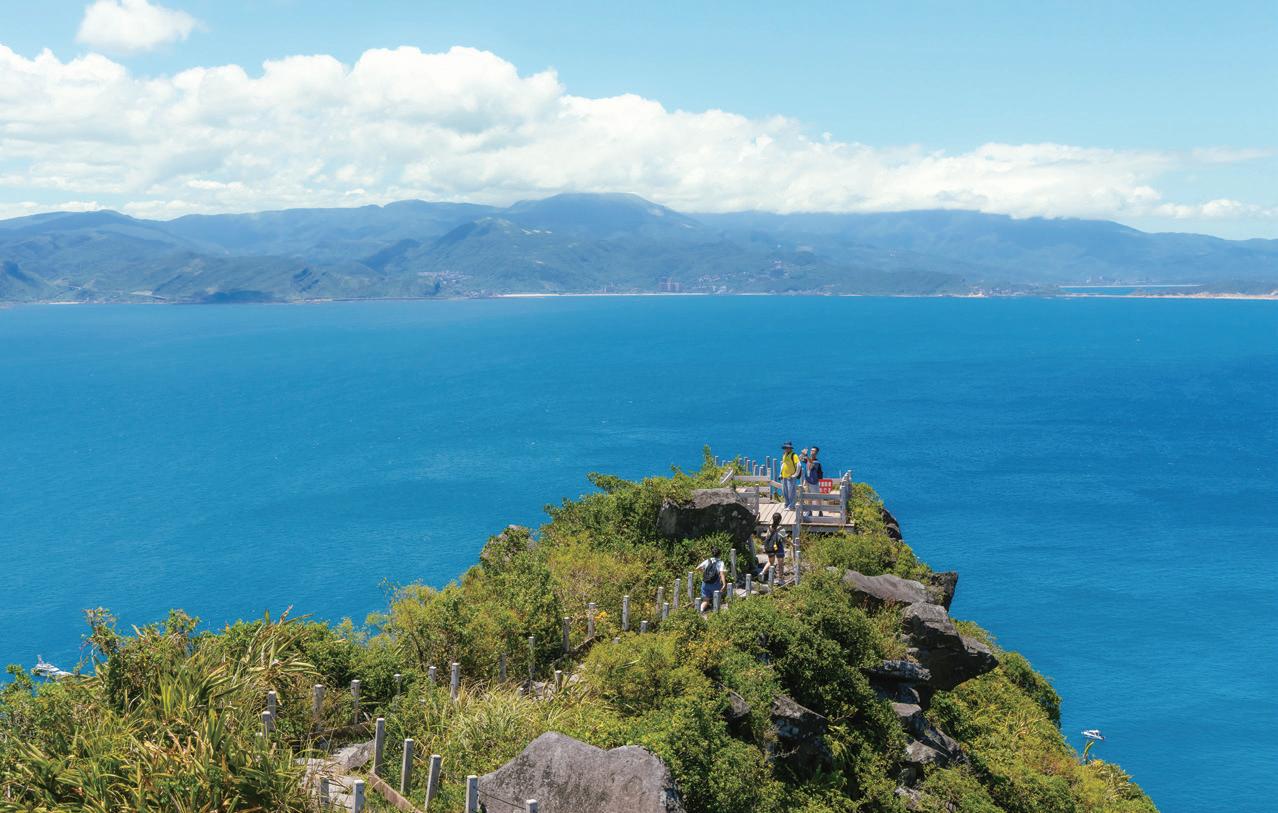




also a viewing deck at the island’s highest point, 182m above the shimmering surface of the ocean.
The lighthouse, when it finally comes into view, is a surprising sight. The octagonal structure has a bold paint job with Beetlejuice black and white stripes, and is decked with an array of solar panels (according to signage, it was Taiwan’s first solar-powered lighthouse). Around it, there are several benches on which weary walkers can take a break, and on a clear day, if you crane your neck to look past the trees, it is just about possible to glimpse the Keelung area’s outer extremities – Pengjia and Mianhua islets (a further 45km and 56km out to sea, respectively, and both off-limits to the general public).
We paused for a while to enjoy the shade and the views, but with our scheduled departure slot approaching, the time soon arrived to head back down to the jetty, having earned both our trail legs and sea legs in a single trip.
Alabao Bay |
Badouzi Tourist Fishing Harbor |
Bitou Cape |
Capybara Rock |
Guanyin | 觀音
Heping Island | 和平島
Hsieh-Ho Power Plant | 協和發電廠
Jiufen | 九份

Jin Long Yacht Club | 晉龍遊艇船隊
Keelung Islet | 基隆嶼
Pengjia Islet | 彭佳嶼
Little Keelung Islet | 小基隆嶼
Mianhua Islet | 棉花嶼
Shen’ao Fishing Harbor | 深澳漁港
Tudi Gong | 土地公
Yehliu Geopark | 野柳地質公園


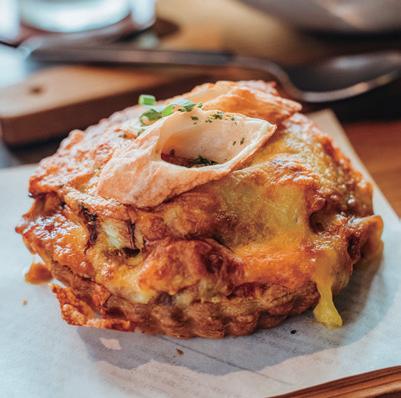

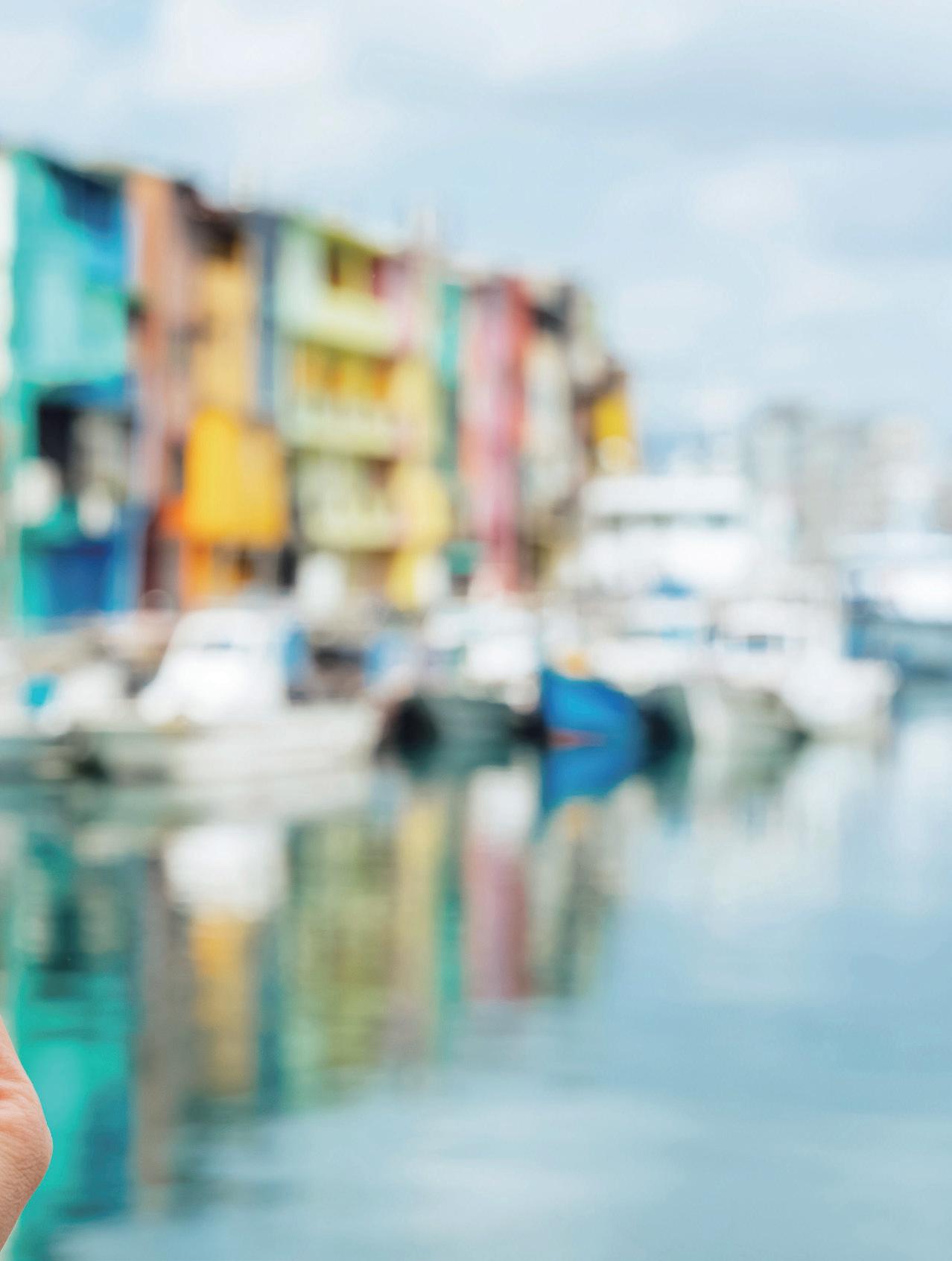
Compact Keelung City is the dividing point for Taiwan’s North Coast and Northeast Coast regions. Local folk love using the quick and convenient commuter train service to zip from Taipei to the Keelung Railway Station, located right by the busy main harbor, for day trips. Why go to Keelung? Stunning ocean views, heritage attractions such as old cannon emplacements on hilltops, and rail-bike rides on an old mining-use line – and food, food, food! – especially at the bustling traditional markets. Miaokou Night Market is the most illustrious name, a short walk east from the railway station. In this article, we introduce three of Keelung’s most iconic snack foods, known as “small eats” in Chinese.
What in the world is a jigula? Here’s a quick dive into the local jigula world.
Wherever you go along the Keelung shoreline, you’ll see fishing boats large and small out on the water, near and far. The two most tourist-visited fishing harbors are Zhengbin Fishing Harbor and Badouzi Fishing Harbor – the narrow deep-water harbor before the railway station is for ships.
No surprise, then, that just-brought-in seafood is front and center on the Keelung buffet table. Jigula is a type of fish cake cooked on a charcoal grill. Fresh, lightly seasoned fish paste is formed around a steel rod, giving it a tube shape, and is then grilled. This results in a smoky flavor and delightful light-crispy “skin.” The paste is most commonly made from fresh-catch flying fish, sailfish, or shark. Usually eaten in the tube form, it’s also sliced up and pan-fried, and used as a unique flavor addition to stir-fries and soups. Miaokou Night Market’s offerings are delicious, but jigula aficionados believe the very best are the very freshest – right at the sides of fishing harbors. Recommended is Zhengbin Fishing Harbor, famed for its picturesque pastel-colored harborside houses, easy to get to from the railway station by local bus.
Jigula, a transliteration of the food’s Chinese characters, is an approximation of Japan’s chikuwa, a similar type of tubular fish-paste cake. Another example of the Taiwan taste for Japanese food items is the local version of tempura, the name bastardized as tianbula. Japan ruled Taiwan from 1895 to 1945 and introduced the tubular-cake preparation method after seeing that Taiwanese fishermen generally did not use shark meat, only the fins. The seasoning is used because shark meat has a very light, mild taste. The jigula preparation process is very labor-intensive; thus, you’ll find the number of sellers limited in comparison to other iconic snack delicacies, making your special Keelung-trip experience all the more precious.
Walking out of Keelung’s railway station, it’s hard to think of pigs and pork. There’s little flat land, high hills crowding in around the harbor. Urban build-up takes up pretty much all space in between. Nevertheless, on the Taiwan foodie culinary map is the city’s iconic “three sausages,” and no, processed marine catch features nowhere in the mix. The three are the pork liver sausage we’ll spend time with here, called zhugan chang, a type of glutinous-rice sausage called dachang quan, and an egg sausage called dan chang
Differing from the usual liver sausage, most often created using a liver paste, Keelung’s unique pork liver sausage is made with cubes of marinated pig liver and diced pork, producing a rich and savory flavor with a distinct liver tinge and a unique texture of initial mild chunkiness that quickly transforms to tender, silky smoothness. It’s believed the Keelung delicacy is a rendition of the pork liver

sausage of China’s Guangdong, learned from transplant Cantonese chefs, but with a lighter, slightly sweeter taste. Production is laborious, done by hand, and as a result, the number of Keelung sellers – primarily small shops and market vendors – is slowly shrinking. As a rule, the sausage is first steamed and then roasted or grilled, bringing a smoky zest to the casing. Use of a dipping sauce is the custom – most sellers have their own “secret recipe” variation, many of which are spicy and possess a tinge of citrus. This balances the richness of the meat. Vendors insist on utilizing only the freshest ingredients and use no preservatives, and will remind customers to eat the sausages within six hours or so. Some of the best-known sellers are on short Xiao 3rd Road, near the railway station, north end looking at the harbor, and at the two-story Ren’ai Market, a little further to the east.
Ah, the tantalizingly named Nutritious Sandwich. Before taking a step further, clarification – this creation ain’t necessarily so nutritious, but it most assuredly is delicious. Now found all around Keelung and all of Taiwan, this calorie-rich delight originated at Miaokou Night Market. What you get is an elongated, oval-shaped wheat bun of happiness that’s been deep-fried, crafting a golden-crispy skin and soft, mildly chewy interior. Stuffed into the middle cut running lengthwise are a variety of yummy things.
Just what yummy things, you’re no doubt wondering. What’s key here is that the sandwich has so many fans not because it brings nutritional value to the table, but because it has a uniquely satisfying medley of textures and flavors.
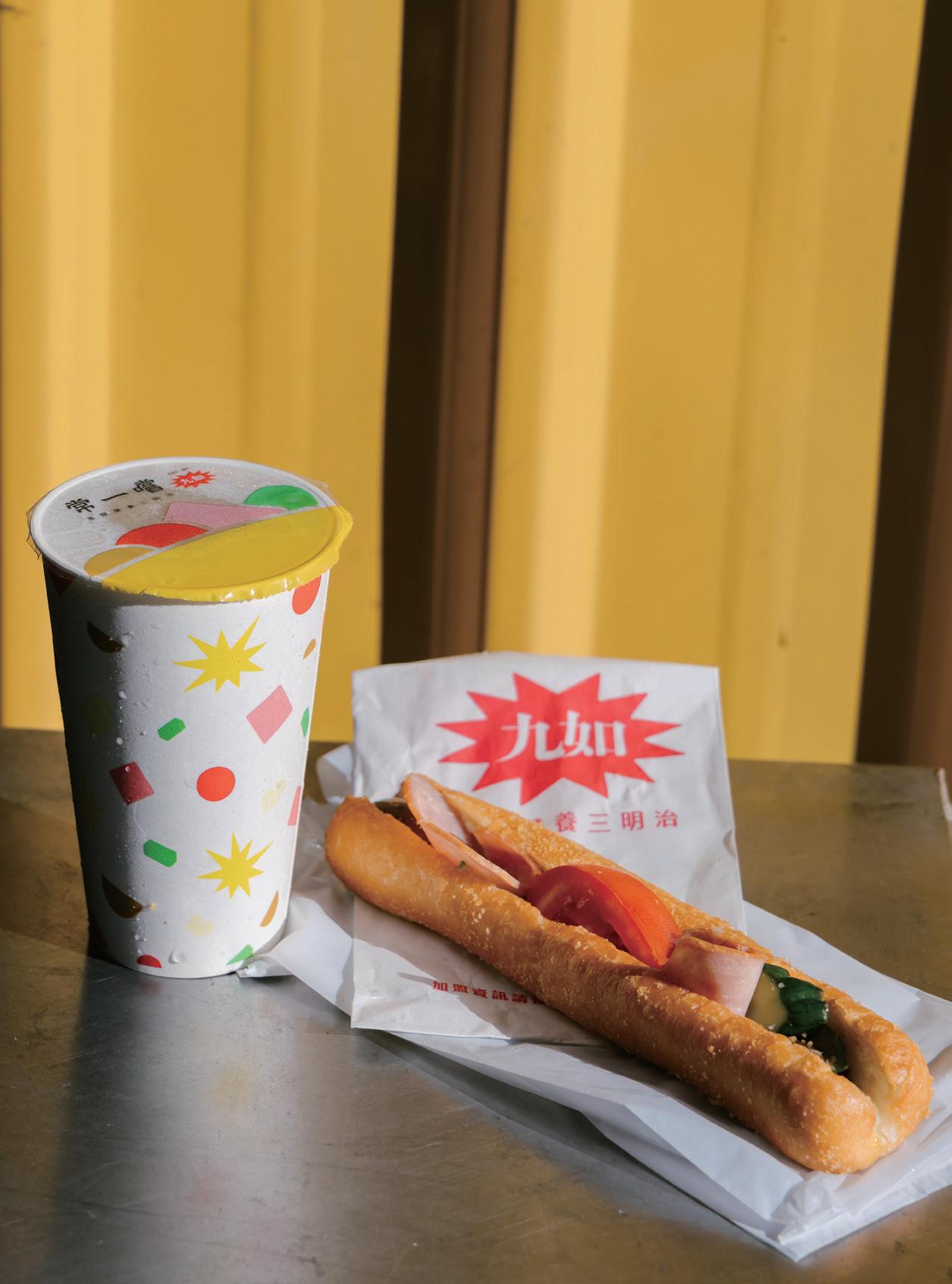
ENGLISH AND CHINESE
Badouzi Fishing Harbor | 八斗子漁港
dachang quan | 大腸圈 dan chang | 蛋腸
Ren'ai Market | 仁愛市場 "small eats" | 小吃 jigula | 吉古拉
Miaokou Night Market | 廟口夜市
Nutritious Sandwich | 營養三明治 pork liver sausage | 豬肝腸 tianbula | 甜不辣
Zhengbin Fishing Harbor | 正濱漁港
The chewy bun has a light sweetness. The de rigueur ham used is savory, as are the slices of soy-sauce-braised boiled egg. Tomato and cucumber slices are fitted in to add a gentle crunchiness. And to help things slide down the gullet nice and easy, a generous helping of mayonnaise is used, lightly sweet, creamy, and rich. Note that many sellers will try to differentiate their offering with a variation of the ingredients or sauce. Be sure to get yours fresh-made hot – the texture of the bread changes quickly with cooling, so you won’t be experiencing the “real thing.”
The sandwich entered the culinary world in the 1950s (some say in the 60s), at a time when there was a pronounced US military presence on the island. Sandwiches not being a known commodity with the Taiwan diner, an entrepreneurial Miaokou vendor created his best take on this iconic Western quick-prepare snack to attract US forces personnel, and voila! a miracle appeared on par with Vietnam’s French-culturenodding, baguette-built take on the sandwich, banh mi. The use of “nutritious” arose from government marketing benefits to promote wheat foods, then largely unfamiliar to the ricefamiliar Taiwan public; wheat flour had been introduced in quantity starting in 1950 as part of US aid efforts.
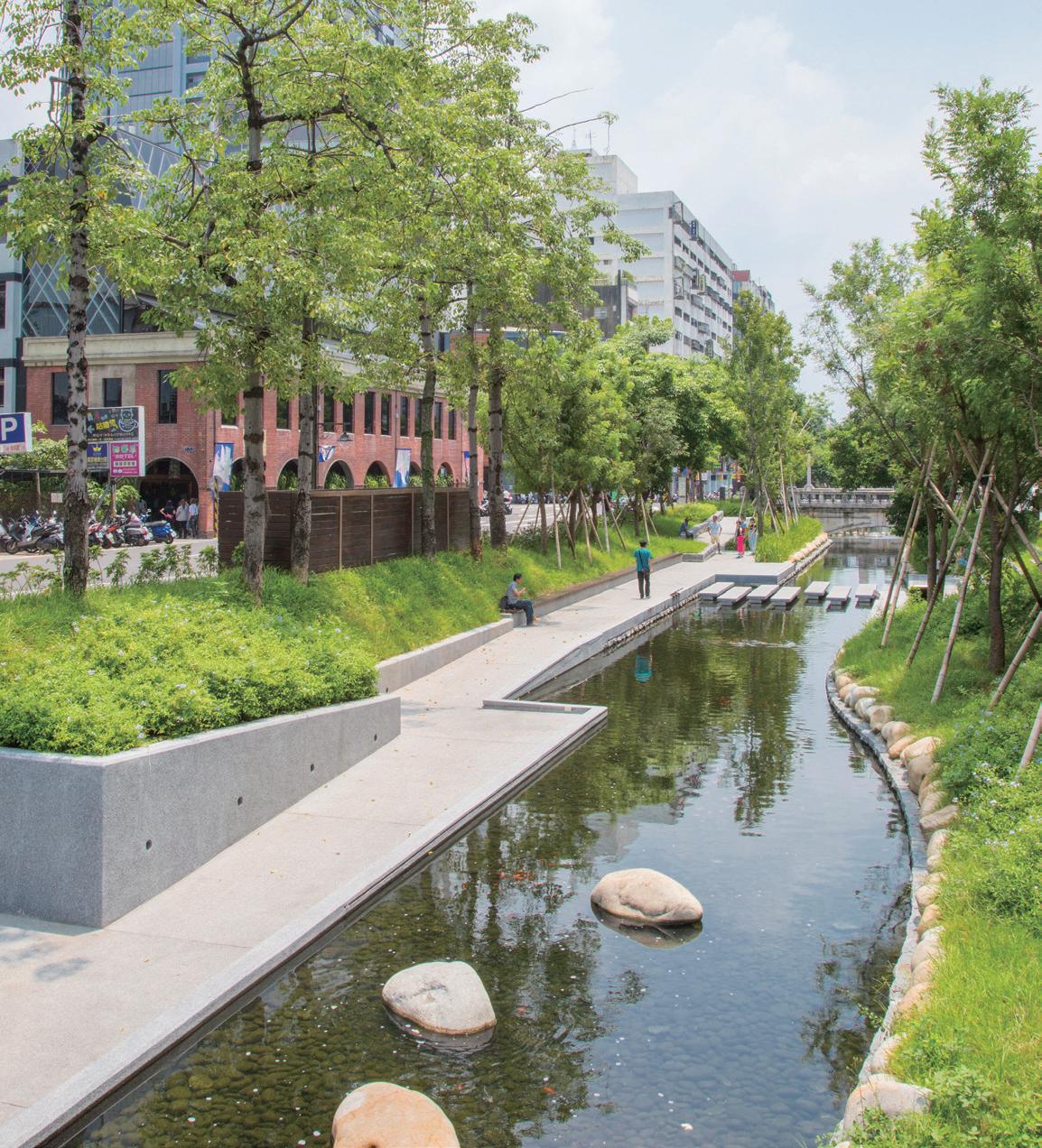
TEXT RICK CHARETTE PHOTOS VISION
Energetic Taichung is the core city of central Taiwan – the “Tai” is short for “Taiwan,” and “chung” means “central.”
In the late 1800s, it was for a moment considered for Taiwan’s capital, thanks to its strategic location and pleasant weather. Let’s explore its heart, filled with heritage charms, big modern cultural facilities, and open green spaces aplenty, plus comparatively few high buildings and low people/vehicle density.



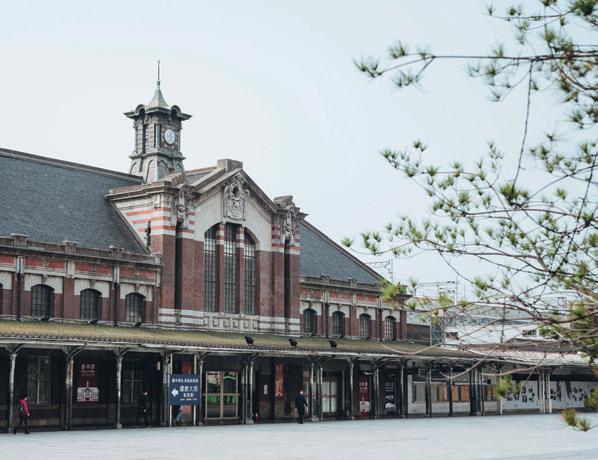




The city’s brilliant new railway station and its old station, a national heritage site, stand side by side. The new facility, a gleaming modern architectural statement of curving lines in glass and steel, was opened in 2017.
The old station, opened by the Japanese in 1917, has a Western Renaissance design, a style popular with the Japanese government for major train stations. The most visually riveting flourish of the resplendent structure – reinforced concrete, redbrick façade, wooden roof sections – is the resplendent clock tower on the central roof. The grand old lady, so central to the city’s identity, one of just a handful of remaining major railway stations from Taiwan’s Japanese era, is now the centerpiece of the 2.9ha Taichung Station Railway Cultural Park (which also includes the new station). Other attractions include the old platforms, freight warehouses, train engines, and the Taiwan Connection 1908 Railway Path . The last runs through the station area along a now-disused track bed. Other facilities currently being renovated include railway dormitories and the retired Taichung Rear Station building.
The gorgeous Taichung Shiyakusho , one of the city’s architectural highlights, is a few old-city blocks (i.e., shorter than modern-era city blocks) to the northwest. This is a flamboyant three-story structure, opened in 1911, built for use as government offices, and serving as Taichung City Hall from 1920 until the Japanese returned home with WWII’s
denouement. This was Taichung’s first architectural work featuring iron-reinforced concrete. Primarily Baroque in design, with a deft fusion of traditional Japanese aesthetics, among the most striking elements are the main entrance’s soaring two-story portico with Ionic columns, the regal classical dome constructed using eight wooden trusses (on view inside), and the façade’s boldly contrasting sections of red and white brick, large arched windows, and refined ornamentation. Inside, period furniture is showcased, and sections of original intricate wooden beam-work have been left exposed for viewing.
After undergoing a virtuoso renovation, the reglorified landmark was reopened to the public in 2016 to provide new service as a cultural-arts center. It provides multifunction spaces used for cultural-arts events and for exhibitions, and is also home to a cultured café and a restaurant serving Northern Italian dishes.
TAICHUNG STATION RAILWAY CULTURAL PARK | 臺中驛鐵道文化園區 (04) 3505-9988
No. 1, Sec. 1, Taiwan Blvd., Central Dist., Taichung City ( 台中市中區台灣大道一段 1 號 ) www.tcrp.com.tw
TAICHUNG SHIYAKUSHO/TAICHUNG CITY HALL | 台中市役所 (04) 2222-0197
No. 97, Minquan Rd., West Dist., Taichung City
( 台中市西區民權路 97 號 ) www.uyes.com.tw
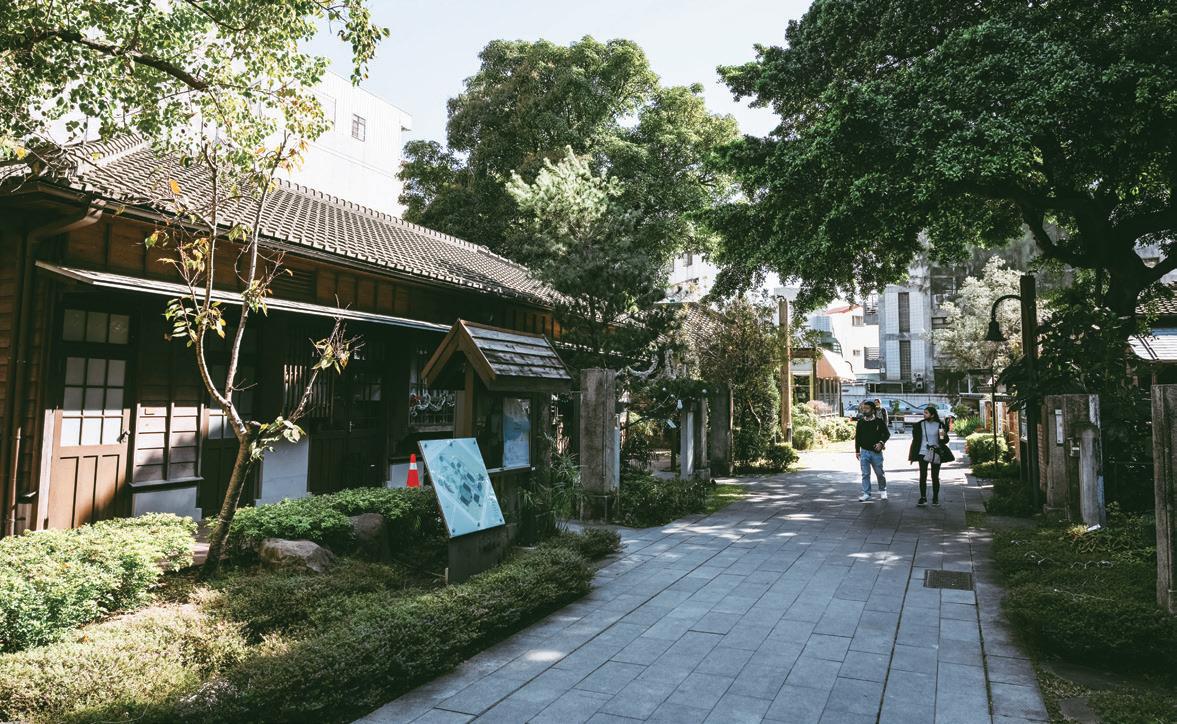
Continue about three blocks northwest of this attraction to reach the tranquil and genteel Taichung Literature Museum , opened in 2016, a compound of painstakingly renovated Japanese classical-style wood buildings shaded by massive venerable thick-trunk banyans planted during the colonial period.
The museum’s structures date to 1932. This was a Japanese police base – police station front and center, dorm and other facilities elsewhere. There are six singlestory buildings, today used for permanent exhibits, special themed exhibits, promotion of children’s literature, workshops and lectures, dining, and administration, respectively.
A tremendous heritage-protected banyan today fills up a courtyard formed by three structures, looking out into the neat rear area Literature Park, with cascades of vines plunging from its towering branches straight down into the ground. One of these buildings houses the quaint and cozy wood-theme NMU Café, serving coffees, tea drinks, cakes, cinnamon rolls, waffles, paninis, and more.
During the Japanese and post-WWII periods, Taichung was a stronghold for literary associations, many also involved in nativist political activity, and since the Japanese era it has been an incubator of literary activity, producing numerous writers of note. The museum’s mission is both to honor the achievements of local literati and to promote literature in Taiwan in this digital age as society’s focus leans toward the video and audio arts.
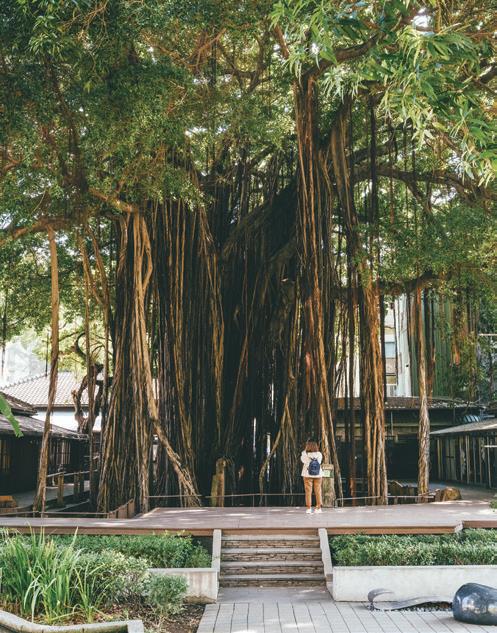
TAICHUNG LITERATURE MUSEUM | 台中文學館 (04) 2224-0875 No. 38, Lequn St., West Dist., Taichung City ( 台中市西區樂群街 38 號 ) www.tlm.taichung.gov.tw



Less than a block north of the literature museum is the long northeast-southwest Liuchuan Canal, which stretches 6.1km through the city, controlling one of four small rivers that wend through the city center. Running along the section near the museum is the Liuchuan Riverside Walk , 610m in length. This green-space promenade, spread out along both sides of the waterway, is especially enticing at night when its bridges, decorative trees, and installation artworks are bathed in romantic mood lighting.
The canal, key in the city’s development during the Japanese colonial era, was neglected and deteriorated badly in the face of Taichung’s rapid population/industrial growth thereafter, particularly in the 1970s/1980s. In the mid-2010s, the city government launched an ambitious remediation project, giving life to a new green space that quickly became a major draw for both locals and tourists after its opening in 2018.
The name “Liuchuan” means “willow river.” The Japanese planted willows along both sides to make the waterway resemble a river that flowed through Kyoto. Willows were reintroduced as part of the rejuvenation project, and you’ll also see effusive examples of the Chinese fringe tree, Taiwanese rain tree, and Himalayan ash, now old enough to provide steady shade through the day.
The highly popular, highly aromatic Taichung Second Market is about five blocks northeast of the literature museum, just south of the riverside walk’s north end, facing Taiwan Boulevard. The labyrinthine indoor market, featuring arcade walkways around its outside, is home to over 300 vendors and is today best known for its classic Taiwanese culinary delicacies.
The core market building was constructed by the Japanese in 1917 as the second of five public markets, with three wings extending radially from a central hexagonal tower that, for a time, was Taichung’s tallest structure and was topped with a bell used as a fire alarm. This was a high-end market serving the district’s comparatively affluent Japanese residents. The word “core” was earlier used because in the post-war period, new, small buildings went up around its exterior, surrounding it. Over the past few decades, varied beautification initiatives have transformed the bazaar into a heritage foodie-focused tourist attraction.
It’s daunting to choose from among the numerous renowned vendors, but we’ll specially recommend Wang Family Turnip Cake and Glutinous Rice Sausage and Shanhe Minced Pork Rice . You’ll see that regulars of the first pair their cake and sausage with tea from Lao Lai Black Tea next door. In a rotation well known among the local regulars, Shanhe runs 5:30am-3pm, the baton then taken up 4pm-3am by the equally beloved Li Hai Minced Pork Rice.
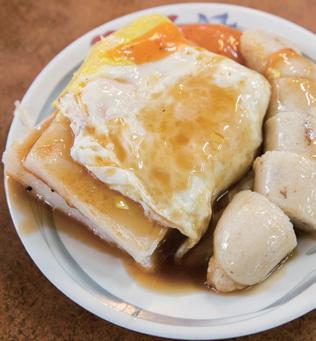
TAICHUNG SECOND MARKET | 第二市場 (04) 2224-0875 No. 87, Sec. 2, Sanmin Rd., Central Dist., Taichung City (
87 號 )
Let’s visit a few high-value tourist hotspots further away from the old city center. You’ll first travel northerly along the aforementioned Taiwan Boulevard , moving from what’s formally called the Central District into the West District. Taiwan Boulevard runs northwesterly away from the train station, eventually meeting National Freeway No. 1 and the main interchange for city core access for folks traveling via motor vehicle.
Our first stop is BeanGood Coffee, opened in 2022, about ten blocks from Taichung Second Market, reachable via a short bus ride along Taiwan Boulevard or a very doable walk. You dive into a grid of quiet old lanes west of the boulevard, the archetypal kind of Taiwan neighborhood where many families use their first-floor shop spaces as their living rooms at night, with drying laundry on wheeled racks out front.
Located on a corner, BeanGood is fully open on both lane fronts, with slim support pillars as the sole entry obstacles. New woodwork has been used to create a stylized rendition of the hardware store that occupied these premises for over half a century, and attractive bench-style seating is found out front. Preserved original elements include signboards, the classic terrazzo flooring, and steep, narrow terrazzo stairs leading up to the second floor. The new shop signage has been done in a historical style by a master painter. At BeanGood, the bean is indeed very good –premium selections sourced from around the globe.


BEANGOOD COFFEE | 冰穀咖啡 0915-572-510 No. 6, Ln. 46, Mofan St., West Dist., Taichung City ( 台中市西區模範街 46 巷 6 號 ) 6pm-12am beangoodcafe.easy.co www.facebook.com/gatescafe

Just three-plus blocks due west of BeanGood is a large greenlawn park, Taichung Civic Square, which is at about the midpoint of one of the city’s best-known tourist attractions, the Calligraphy Greenway. This is a long 3.6km strip of green space, wide at its north and south ends, plus at its Civic Square mid-point, and comparatively slender in between.
At the north end is the global-caliber National Museum of Natural Science (www.nmns.edu.tw ) and, beside it, the 4.5ha Botanical Garden . Tourist faves – the museum’s domescreen Space Theater (science/ecology films) and the Tropical Rainforest Greenhouse. Landscaped Taichung Civic Square, which annually serves as a stage for the acclaimed international Taichung Jazz Festival, buzzes with buskers and other entertainment on weekends/holidays. Its north neighbor is Park Lane by CMP, a multi-story transformed parking garage now an urban garden, façade featuring vertical gardens, interior an upscale retail/culture space. The south end’s eminent National Taiwan Museum of Fine Arts (www.ntmofa.gov.tw), key focus modern and contemporary creations by Taiwan artists, has a vast collection surpassing 19,000 works.



The swankly modern yet tradition-celebrating Traditional Market (www.parklanes-shop.tw) is close to the National Museum of Natural Science, in the highend The Splendor Hotel Taichung high-rise building, beside Taiwan Boulevard. Taking up the third floor, it’s part of the multi-floor Park Lane by Splendor mall –Taiwan’s first-ever wet market in a mall, with about 50 stalls. The inimitable traditional spirit of the classic wet market, today enduringly an integral part of everyday Taiwan life, is integrated with the modern design and hardware (air-conditioning!) of a department store. Browse everything from iconic old-timey prepared foods and snack treats to fresh meats, seafood, fruits, and veggies to daily necessities. As well, consider a revivifying on-site massage from a blind masseuse, another classic Taiwan experience.
Note that “Taichung Sixth Market” is incorrectly used in many English websites, a direct translation of the mall’s Chinese name. This is a reference to the earliermentioned five major markets planned by the colonialera Japanese authorities.
TRADITIONAL MARKET | 第六市場 3F, No. 1049, Jianxing Rd., West Dist., Taichung City ( 台中市西區健行路 1049 號 3F)
ENGLISH AND CHINESE
Lao Lai Black Tea | 老賴紅茶
Li Hai Minced Pork Rice | 李海魯肉飯
Liuchuan Riverside Walk | 柳川水岸廊道
Park Lane by CMP | 勤美 誠品綠園道
Shanhe Minced Pork Rice | 山河魯肉飯
Taiwan Connection 1908 Railway Path | 臺中綠空鐵道
Taichung Civic Square | 台中市民廣場
Taichung Railway Station | 臺中車站
Taichung Rear Station | 臺中後站

Wang Family Turnip Cake and Glutinous Rice Sausage | 王家菜頭粿糯米腸
Autumn in Taipei means one thing above all for Taipei’s foodie set: hot-pot season. As the nights turn cooler, the city’s bubbling cauldrons start calling. From the mutton-rich flavors of More Joy Young to the beefy indulgence of Red Ox Brother to the fiery Sichuan spiciness of Chan Chi Hot Pot Lab, Taipei simmers with irresistible choices.



The interior is as fiery red as the broth at Chan Chi Hot Pot Lab, a trendy Taipei hot-pot institution. The retro flair begins with the neon sign outside and continues through the folding metal stands, stainless-steel fittings, and burnt-umber walls, laminate floor, and brickwork in this basement-level restaurant. Given the old Taipei vibes, one might think this branch of the threeoutlet group in Taipei City’s Ximending area is the original, but that honor actually belongs to the Xinzhuang District location in New Taipei City. Don’t let the old-school vibes fool you: this is where the local youth go for hot pot.
The star of the show at Chan Chi is the mala soup base, known for being one of the hottest in Taiwan. Jellied duck blood turns the broth into a dark flavor bomb, along with Sichuan numbing spice and countless red chilis. If you’ve ever wanted to know what a “chili high” (a real phenomenon triggered by the peppers’ capsaicin) feels like, this is the place to get one. A clear broth is also available on its own or in a divided pot if you think your tongue can’t handle it.
The point of hot pot is to cook the ingredients in the soup base yourself, and Chan Chi has some of the best in the city. Squid and shrimp paste with fish roe and tofu are popular choices, as they soak up the hot broth, and tougher meat dishes such as tendon and intestine turn soft and delicious in the bubbling pot. Safer options include thin-sliced pork belly and a variety of meatballs: shrimp, pork, beef, taro, and mushrooms. A generous sauce bar encourages guests to build their own perfect dipping blend, from sesame oil and vinegar to raw garlic and fiery chilies.




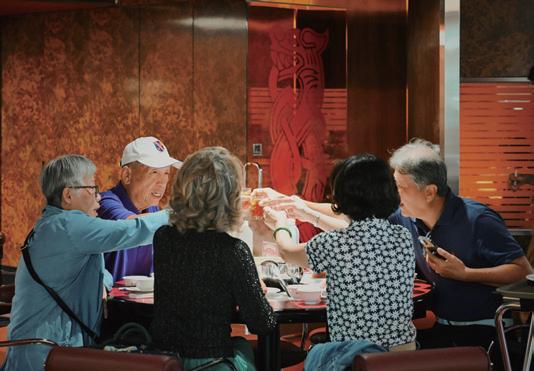
CHAN CHI HOT POT LAB – XIMEN GREAT WORLD | 詹記麻辣火鍋 - 西門大世界 (02) 2311-1800
B1, No. 81, Chengdu Rd., Wanhua Dist., Taipei City ( 台北市萬華區成都路 81 號 B1) 12pm-1am www.instagram.com/chanchihotpotlab www.facebook.com/ChanChiHotPots

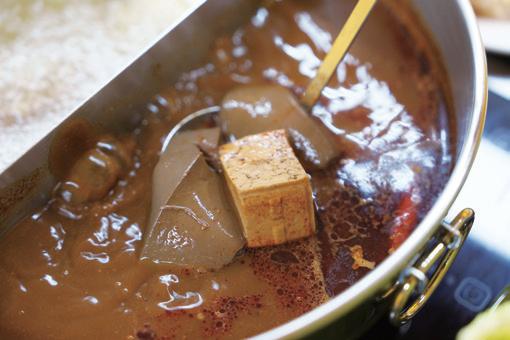

When the mutton hot pot is bubbling at any of the branches of this venerable Taipei establishment, you can smell it from the street. Warm, slightly gamey mutton tinted with ginger beckons you inside, especially on a chilly day. More Joy Young specializes in mutton: its hot pot is renowned across Taiwan, and each side dish boasts its own unique flavor profile. The Songshan District location in Taipei City is the oldest, opened in 1992, and the branches in the city’s Da’an and Neihu districts have each been open for about two decades. The Da’an branch is bright and spotless, with the large upstairs windows letting in natural light and the sight of leafy treetops. More Joy Young frequently features in the island’s media and has been included in the United Daily News’ 500 Dishes guide for several years.
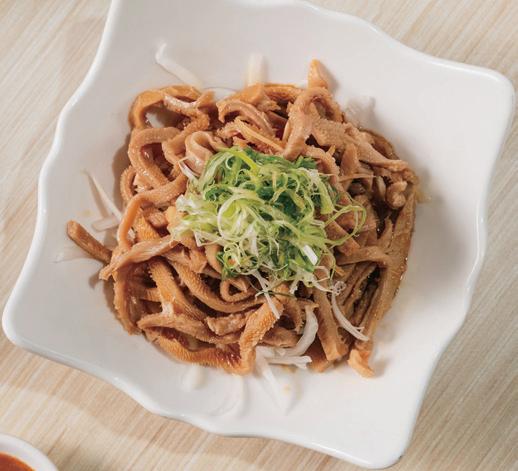
The most popular dish is the signature mutton hot-pot set for two, which can be shared among a larger group with the addition of a few side dishes. Larger hot pots are also available. The broth is rich and complex, prepared by simmering mutton bones and tougher meat cuts for three to four hours. Both clear stewed and soy sauce-braised “red” broth are available, as well as divided pots with both. The clear broth is lighter, suitable for all types of weather, including Taipei’s warmer autumn days. January to March are the chain’s busiest months; customers will find it easier to get a table in midautumn or spring.
Enoki mushrooms and a heaping portion of julienned ginger are added before bringing the pot to the table, giving the broth depth and a sweetish spice undertone. Lamb meatballs, vegetable balls, and whorls of thin-sliced mutton shoulder, all cooked at the table, are popular additions. Cubed tofu or tofu skin, cabbage, and other typical hot-pot sides fill out the meal.
The set for two includes several side dishes: stir-fried seasonal vegetables, chilled mutton stomach, sesame-oil thin noodles, and shacha mutton. The stomach has an excellent mouthfeel without being overly chewy, and is prepared in a fiery-red chili oil; the shacha mutton is a delicate balance of briny, spicy, smoky shacha sauce and sliced meat. The sesame-oil noodles taste great on their own and in a bowl with some of the hot-pot broth.


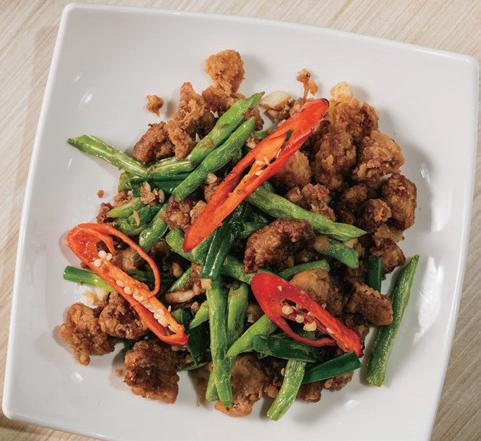



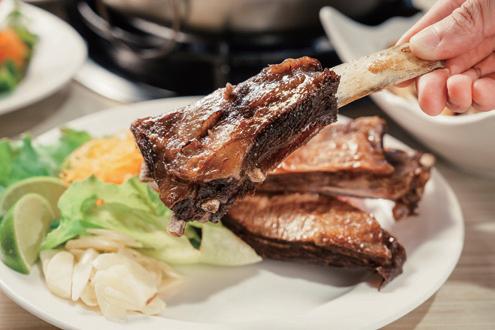
Traditionally, mutton hot pot comes with a preservedtofu dipping sauce made with tangy fermented tofu, the strong flavor pairing well with gamey mutton. More Joy Young’s preserved-tofu sauce is made in-house. The flavors of both the broth and preserved-tofu sauce are reminiscent of southern Taiwanese cooking; Tainan City natives have been known to come here seeking comfort food that reminds them of home. According to traditional Chinese medicine, mutton hot pot is warming (in the medicinal sense as well as temperature), stimulating and nourishing for all manner of organs, including the liver and gallbladder.

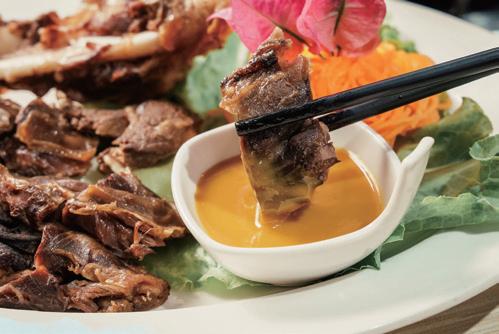


Don’t miss the other side dishes, many of which are beloved in their own right. The dry-fried mutton rib strips are a standout: tenderized rib meat is breaded and fried with a Taiwanese fried chicken salt-and-pepper seasoning and topped with dry-fried green beans and heaps of garlic. It pairs perfectly with beer or More Joy Young’s custom-made sake. Mutton with basil tops the spice charts and has an herbal kick, and the chashao ribs come in thick slabs you can sink your teeth into, and have the sweetness of the famous chashao pork buns. The lemon cuts the sweetness, and the garlic adds an allicin tang. The best-known side dish is the French-style mutton shank. The shank is roasted until it’s fall-off-the-bone tender, carefully seasoned with a European flavor profile, and served with a spicy mustard dipping sauce.
MORE JOY YOUNG | 莫宰羊 (02) 2369-1466
No. 28, Sec. 3, Xinsheng S. Rd., Da'an Dist., Taipei City ( 台北市大安區新生南路三段 28 號 ) 11am-2pm, 5pm-1am www.mjy.com.tw www.instagram.com/morejoyyoung ww w.facebook.com/fans.mjy




The “red” in “Red Ox Brother” isn’t your ordinary red. The Chinese character used, 赤 , denotes something closer to crimson or carmine: specifically, the bright, bloody color of raw beef. Where More Joy Young specializes in mutton, beef is the name of the game at Red Ox Brother. Founded over 70 years ago in Pingtung County in the south, Red Ox Brother opened its doors in Taipei in 2014 to great acclaim, and has since been called the best Shantou-style hot pot in the city. The interior is comfortable and moody, with black leather chairs and red lanterns. The restaurant is tucked away in a quiet lane just south of Xingtian Temple, a major tourist attraction.

Shantou hot pot is a traditional style of hot pot from the Chaoshan region of China’s Guangdong province. It has become very popular in communities of Chinese immigrants who settled in Southeast Asia. The key ingredient is shacha, a sauce blend that varies by region but commonly contains ingredients such as peanut powder, dried seafood or fish, shallot, red chili, soy sauce, sesame, garlic, and oil. It’s a relative of Southeast Asia’s satay sauce. Shacha can be used as a stirfry flavoring, dipping sauce, soup base, and more.
Red Ox Brother makes its own, taking pride in imbuing it with a pungent flavor that is neither too heavy nor too greasy. It’s so popular that it’s also sold in jars for customers to take home. The “shacha bar” at Red Ox Brother includes the signature shacha, as well as sesame oil, minced garlic, hot chili, green onion, and slivered ginger. Some believe shacha pairs particularly well with beef, as it removes the “fishy” taste of raw meat.





The restaurant has two signature soup bases: a clear broth with preserved vegetables, goji berries, and licorice root; and a flatfish broth with shacha. As in many hot-pot restaurants, divided pots with both broths are available. The clear broth hints at traditional health concoctions without being overly medicinal, and the flatfish broth is deep and aromatic.
Ingredients to cook in the hot pot, taken from the refrigerators at the back, are sold at various price points. The most popular dish is also the most difficult to get: Tainan “warm body” beef. This beef, which is only produced in Tainan, has never been refrigerated; to ensure food safety, it must be served the same day the animal is slaughtered. It is prized for its delicate flavor and tenderness, which are believed to be impacted by refrigeration. The unique production method for such beef means that only a limited amount is available each day. Customers who are lucky enough to get it will often dip it in the hot pot for only a few seconds, just enough time to give it a lightly cooked exterior but otherwise remain rare. The flatfish shacha broth is often touted as a superior pairing for “warm body” beef, but this is a matter of personal preference.
Red Ox Brother offers many other cuts of beef for hot pot, too. Some of the choicest options include A5 Japanese wagyu and marbled beef sliced in paper-thin strips. Brisket and ribeye are also available, as well as beef tendon and tongue. The handmade beef meatballs have a springy mouthfeel and deep meaty flavor, and are served with cuttlefish meatballs colored black with the cuttlefish’s natural ink.
Although most customers zero in on beef, don’t overlook Red Ox Brother’s seafood offerings. The seafood paste, served in a half-cylinder, is a unique offering. It’s made with fish, shrimp, and imitation shark fin, and it’s scooped into the hot pot, where it solidifies. The double seafood platter provides especially good value: it comes with generous slices of Taiwanese tilapia, whole neritic squid, clams, and massive, fleshy shrimp. Handmade dumplings from Keelung, a north Taiwan harbor city, are available in limited quantities and feature a variety of fillings, including fish, shrimp, and pork.
RED OX BROTHER SHANTOU HOT POT | 赤牛哥汕頭火鍋 (02) 2518-1922
No. 2, Ln. 313, Songjiang Rd., Zhongshan Dist., Taipei City ( 台北市中山區松江路 313 巷 2 號 ) 11:30am-2pm, 5pm-9:30pm www.redoxbro.com www.instagram.com/redoxtp www.facebook.com/RedBullBrotherHotPot
ENGLISH AND CHINESE chashao ribs | 叉燒羊肋
chilled mutton stomach | 涼拌羊肚 clear stewed | 清燉
double seafood platter | 雙人海鮮拼盤
dry-fried mutton rib strips | 乾扁羊肋條
French-style mutton shank | 法式羊膝 mala soup base | 麻辣火鍋 mutton hot pot | 羊肉爐 mutton with basil | 九層羊肉 sesame oil thin noodles | 麻油麵線 shacha (mutton) | 沙茶 ( 羊肉 )
Shantou-style hot pot | 汕頭火鍋
soy sauce braised | 紅燒
stir-fried seasonal vegetables | 炒時蔬
Tainan "warm body" beef | 台南溫體牛
tofu dipping sauce | 豆腐乳醬
Ximending | 西門町
Xingtian Temple | 行天宮



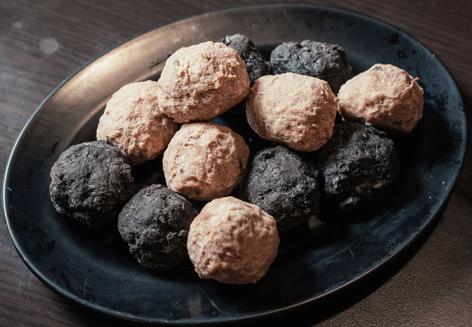



Once a core part of Taiwanese urban life, the sight of mobile roadside vendors is slowly fading in modern cities. These informal business operators have a rich history intertwined with Taiwan's economic development and social fabric. TEXT & PHOTOS VISION

The roots of Taiwan’s street-food culture trace back centuries, but it truly flourished after World War II. As the island rapidly industrialized, rural folk moved to the cities in large numbers. Mobile vendors, often operating from simple bicycles, tricycles, or motorcycles equipped with carts, started offering a convenient and affordable way to feed the burgeoning urban workforce. Some used small trucks to transport more elaborate setups, sometimes equipped with gas stoves for cooking. Taking advantage of a path to entrepreneurship with low barriers to entry, these vendors provided – and still do so today – an essential social function, serving as hubs for community interaction.
Specific traditional snacks have become synonymous with these operations, each requiring its own unique equipment.



For example, the vendors selling egg cakes and adzuki bean cakes use specialized molds and small, mobile grills. Other stands feature large griddles for cooking scallion pancakes, while some vendors specialize in runbing with a variety of fresh fillings. The simple carts selling ice cream often announce their arrival with the distinct sound of a bicycle horn, ba bu ba bu. A loud bang signals the presence of a vendor making puffed rice on the spot. The sound comes from the traditional pressurized machine used to make the treat, which releases a burst of steam accompanied by a loud, explosive noise as the rice puffs instantly. Another common sight is purveyors who grill savory pork sausages, a beloved and fragrant snack often served with a slice of raw garlic.


In today’s fast-paced, high-tech cities, the presence of these street hawkers is declining. Several modern factors drive this shift. Ever-denser urban development and stricter government regulations have played a significant role. City governments, aiming to improve traffic flow and sanitation, have often restricted or relocated vendors. The younger generation, facing the challenges of long hours and precarious income, is less willing to take on the difficult work, resulting in a lack of new talent to continue the tradition.
Furthermore, changing consumer habits have contributed to the decline. The rise of sophisticated night markets, which are more organized and regulated, along with the expedience of omnipresent convenience stores and online food-delivery services, has reduced the need for roadside vendors that appear and disappear more serendipitously. While these vendors are not gone entirely, their informal, chaotic charm is increasingly being replaced by more structured, permanent food establishments. They are becoming a cherished memory, a symbol of a simpler time that is slowly being phased out by modernity.

So, when visiting Taiwan, if you hear the ba bu, ba bu sound of an ice-cream cart, or the big bang of a puffed-rice maker parked by the side of the road, make sure to take a pic and pick a snack, because the next time you’re in town the vendor might well have retired, never to be replaced by someone from the younger generation.
ENGLISH AND CHINESE adzuki bean cake | 紅豆餅 ba bu | 叭噗 egg cakes | 雞蛋糕 ice cream | 冰淇淋 puffed rice | 爆米香 sausage | 香腸
For purists, the idea of adding anything to coffee is often met with disdain. They prefer simple, unadulterated brews made with single-origin beans, using methods such as a pour-over or French press. In contrast, more casual coffee drinkers are open to a wide variety of flavorings. Let’s explore some that are trending in Taiwan these days, from osmanthus honey to kaoliang liquor!
Fika Fika Cafe ( fikafikacafe.com) in Taipei is renowned for its high-quality coffee and minimalist, Nordic-inspired decor. Founded by award-winning roaster James Chen, the café offers a range of specialty drinks that attract both coffee aficionados and casual drinkers. Among its most popular selections are the Black Sugar Latte, known for its rich, caramelized flavor, and the refreshing Mojito Mint Iced Latte, which offers a unique, cool twist on a classic.
A singular creative coffee by the multi-city chain ComeTrue Coffee (www.cometrue-coffee.com), winner of a silver medal in an important Taiwan creative coffee competition, is Cheerup. The drink combines iconic Taiwanese flavors in a single cup, featuring a blend of guava, plum, licorice, and Daebete tea, mixed with espresso. The bottom layer is a house-made juice from fresh guava, while the top is a whipped espresso that has a frothy, rich texture.
Hui Sun Coffee ( huisun.tw), a small 4-outlet chain, has created the Puffed Rice Latte , a distinctive drink that also blends coffee with flavors typical of Taiwan. It features the rich aroma of roasted rice, reminiscent of puffed-rice cakes, combined with the smooth taste of a coffee latte. This café uses coffee beans sourced from small local farms, reflecting the brand’s commitment to supporting local agriculture.

The Kaoliang Steamed Osmanthus Coffee Latte by SanFormosan Café ( sancoffee.shop), another small, budding chain based in Taipei, is a unique drink that incorporates a renowned local liquor. During the steaming process, the beans absorb the aroma of the alcohol, which evaporates during the subsequent high-temperature roasting, so the coffee itself is non-alcoholic but retains a rich, boozy fragrance.
Curista Coffee (www.facebook.com/curista.coffee), another small Taipei group, offers a special Taiwanese Wax Gourd Latte with Brown Sugar Jelly option, a unique combination of classic coffee latte with traditional winter melon tea. The tea adds a distinctive caramelized aroma and sweetness that contrasts with the coffee’s richness and the milk’s smoothness.
ENGLISH AND CHINESE
Black Sugar Latte | 黑糖拿鐵 Cheerup | 甘芭爹
ComeTrue Coffee | 成真咖啡 Curista Coffee | 奎士咖啡
Daebete tea | 茶米茶
Hui Sun Coffee | 惠蓀咖啡
Mojito Mint Iced Latte | Mojito 薄荷冰拿鐵
Kaoliang Steamed Osmanthus Coffee Latte | 桂花蜜釀酒蒸拿鐵
Puffed Rice Latte | 小農米香咖啡拿鐵
SanFormosan Café | 森高砂
Taiwanese Wax Gourd Latte with Brown Sugar Jelly | 台灣冬瓜粉粿拿鐵
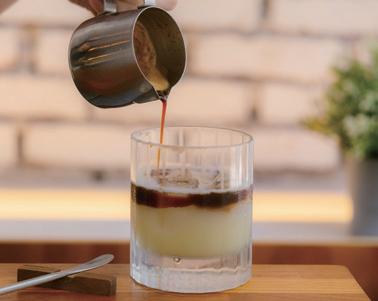













Taichung’s Air Hub
Taichung International Airport (www.tca.gov.tw), located in the Shalu District of Taichung City, previously served as the Ching Chuan Kang Air Base, which succeeded the Kokan Airport, built by the Japanese in 1936. During the Vietnam War, the air base was a critical logistics hub for the United States Air Force in Asia. It was gradually opened to civilian flights starting in 2004, and in 2013, a new terminal was completed, expanding its capacity to serve as a major international air hub for central Taiwan. This modernization has been crucial in handling the significant increase in annual passenger volume, which in 2024 reached approximately 2.12 million. The airport provides direct flights to a diverse array of destinations, including key regional hubs like Hong Kong, Macau, and Nanjing, as well as popular cities in Japan, South Korea, and Vietnam, catering to both business and leisure travelers.



Taichung International Airport (RMQ) is the primary gateway for central Taiwan. Serving as a crucial hub for both domestic and international travel, the airport connects the Taichung metropolitan area with destinations across East Asia, supporting the region’s vibrant economy, particularly its tourism industry.







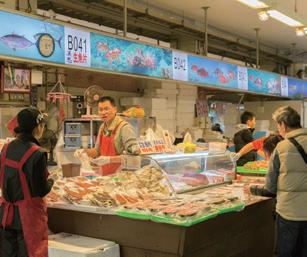
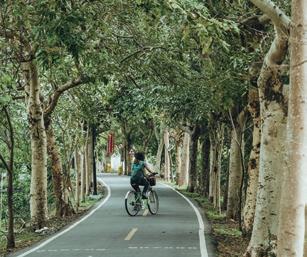







Travelers arriving at or departing from the airport have several convenient transportation options. Public bus services, such as route 156, provide a direct link to the Taichung High Speed Rail Station (www.thsrc.com.tw), a major transportation node that connects to the rest of Taiwan. Other bus routes, like route 302, offer an easy and affordable way to get to the city center (including Taichung Railway Station). The airport’s strategic location also makes it an excellent starting point for exploring other nearby attractions. Just a short drive away is the renowned Gaomei Wetland , famous for its breathtaking sunsets and diverse ecosystem, which attracts migratory birds. The bustling Wuqi Tourist Fishing Harbor is a great place to experience local culture and enjoy fresh, high-quality seafood. For those seeking an active outdoor experience, the Tanya Shen Green Bikeway offers a scenic pathway for cycling. Additionally, the new Taichung Aquarium (tcaqua.com.tw) provides an engaging and educational experience with its unique exhibits on marine life and aquatic environments.
ENGLISH AND CHINESE

Ching Chuan Kang Air Base | 清泉崗空軍基地
Gaomei Wetland | 高美濕地
Shalu District | 沙鹿區



Taichung Aquarium | 台中海洋館
Tanya Shen Green Bikeway | 潭雅神綠園道



Wuqi Tourist Fishing Harbor | 梧棲觀光漁港

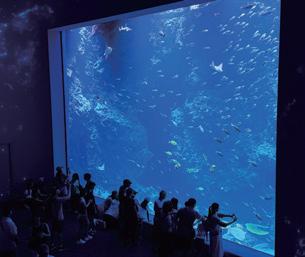




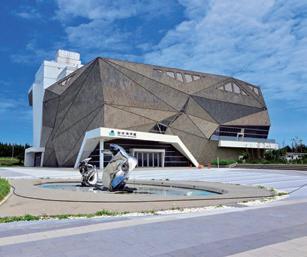


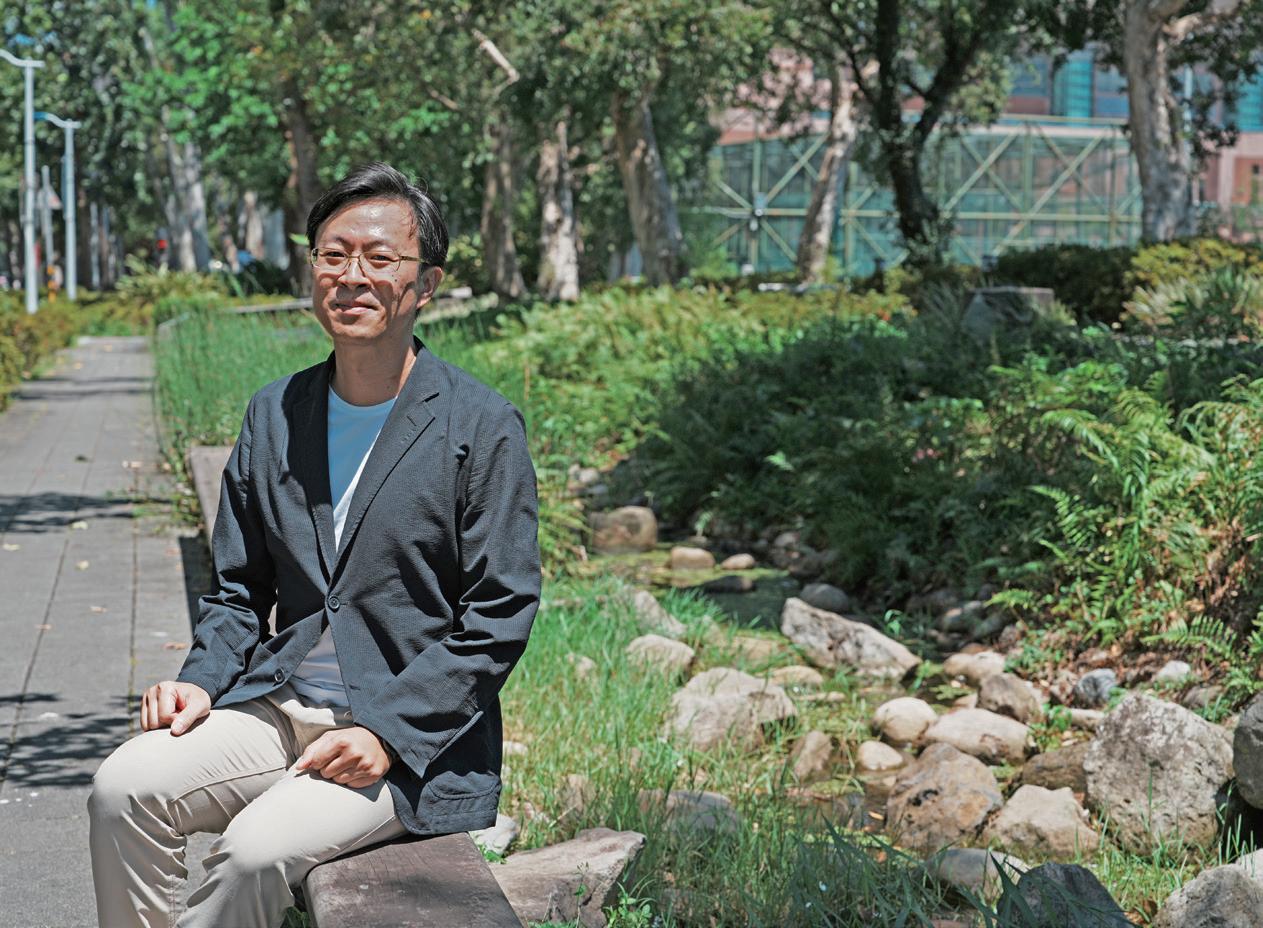
Open House Taipei “opens” usually off-limits spaces to the public, celebrating the city’s architecture, history, and creative culture. Founded in 2020, this free, volunteer-driven yearly event encourages dialogue about how thoughtful design can enhance public life and explores future possibilities for urban living.
For one weekend every November, spaces usually off-limits in Taipei are opened up to visitors for free: annual favorites include the MRT Operations Control Center, the roof and catwalk at both the National Theater and Concert Hall, and the 117-year-old Guanyinshan Reservoir, located near the Museum of Drinking Water and nicknamed the “underground water palace.”
Around 80 other sites will also be accessible through this year’s Open House Taipei, set for November 22 and 23, with volunteers guiding visitors through the city’s hidden stories. The festivity also offers themed tours and special activities – even a photography contest – all designed to spark dialogue about architecture, history, and urban life.
The Taipei happening is part of a global initiative that began in London in 1992 and now spans more than 50 cities. Richard Hsu, who co-founded the local edition in 2020 during the COVID-19 pandemic, says that beyond piquing curiosity, the celebration helps the public better understand architectural ideas, how spaces are used, and how thoughtful design can improve public life.
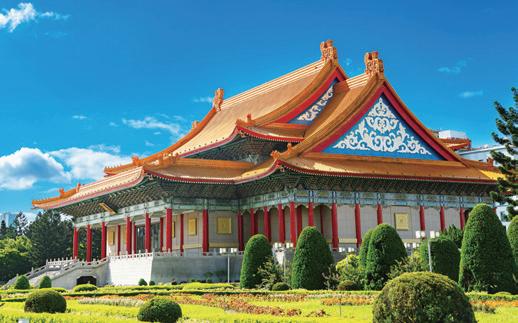

Some popular sites require advance registration on the official website and fill quickly, while about half allow walk-ins. The program has led to many discoveries as volunteers dig into the pasts of participating spaces. At the Yuanshan Tunnels – two secret underground passages located at the Grand Hotel – for example, an elderly visitor revealed that she had once worked for a radio station nearby, answering many lingering questions about structure and usage that the team had wondered about.
Hsu’s enthusiasm for Taipei’s architecture and urban design is contagious. He vividly describes what makes each site compelling – not just its aesthetics, but its social functions and future potential. “Taipei may seem chaotic, but it’s also comfortable and convenient,” he says. “And there are many reasons, reflected in the architecture, for why the city has developed this way. To me, Taipei is really about the collision of Eastern and Western cultures, constantly adapting to daily life with a flexible, pragmatic spirit.”
When Hsu studied design management in London more than a decade ago, however, he struggled to describe Taipei to others. In addition to attending his first Open House there, he was captivated by how locals were able to effortlessly explain their buildings and neighborhoods. “It felt like in every block, people knew its history by heart,” Hsu recalls.
Back in Taiwan, he helped coordinate projects such as World Design Capital Taipei 2016, international design exchanges, and various government cultural-creative initiatives. Nevertheless, he remained drawn to the grassroots, volunteer-driven, community-focused character of Open House, with its focus on public interaction and dialogue.


In 2018, he teamed up with Andoni Munduate, who had worked with Open House Bilbao in Spain. Munduate had noted that Taiwan had plenty of outstanding architecture and design elements, but that locals were not accustomed to presenting them to outsiders. He wanted to launch an Open House in Taipei to change this.
After lengthy preparations and obtaining approval from London, the pandemic hit, and Munduate could not return to Taiwan. Still, Hsu and the remaining team pushed ahead, making Taipei only one of two cities that year to hold a physical Open House. It was a success, with nearly 30,000 people visiting over 50 sites with the help of about 400 volunteers.
Ironically, the pandemic may have helped, Hsu says, as major institutions such as the National Theater and Concert Hall had time and incentive to join since foreign performers could not visit the island. Individual performance groups have also joined – last year, Cloud Gate Dance Theatre opened up its rehearsal and living quarters.
Public works also feature in the yearly roster. Few knew about the underground Guanyinshan Reservoir, used to store water for the city from 1908 until 1977, then remaining closed until 2019. Its spacious, cathedral-like chamber has drawn comparisons to Istanbul’s Basilica Cistern, but more importantly, it sheds light on the city’s modernization. Open House Taipei has expanded on the waterworks theme with an “Open River” tour, tracing the irrigation canals that once crisscrossed the city but have now gone underground.

“In addition to the history, we also discuss how reopening these waterways can help relieve the heat during Taipei’s sweltering summers,” Hsu says. “It’s about creating new types of public spaces in the city, and helping people see the connections behind these sites.”
Architecture and design studios have also joined, along with small crafts workshops tucked away in Taipei’s alleys – a hidden creative energy that Hsu says is part of the city’s charm. Open calls are held each year to find new gems.
Hsu says he’s struck by the remarkable energy of Taipei’s community of volunteers, many of whom are in their 30s and eager to explore unfamiliar corners of the city. “After traveling abroad, they start to ask themselves: how do I explain my city to foreigners? That awareness grows, and that’s why they’re willing to volunteer,” he says.
The event has broadened in scope over the years, rolling out new activities and tackling annual themes such as sociability, sustainability, and inclusivity. This year’s focus is “Future Heritage,” which asks how cultural sites can be given new life, and how today’s designs can shape the city’s future, Hsu says.
One timely topic is social housing, a pressing issue as Taipei’s real-estate prices soar. Hsu points to the Minglun Social Housing Complex, a converted elementary school completed in 2020, which now combines housing, creative enterprises, and an elevated running track. The Guangci Charity Park Social Housing Complex is another example, emphasizing large shared areas and public artworks to redefine modern living.


Other theme highlights include the transformation of historic neighborhoods like Hengyang Road and Dihua Street into vibrant, modern creative districts, as well as Taiwan’s first planned mountainside community, Garden City – the visionary project of Hsu Tse-lan, Taiwan’s first female architect.
To broaden participation, Open House Taipei is also collaborating with French photography publishing house YellowKorner on a photography contest, inviting people to capture Taipei’s landscape under the theme of reinterpreting and reimagining the city’s future.
OPEN HOUSE TAIPEI
( 打開台北 ) www.opentaipei.org www.facebook.com/OpenHouseTaipei
ENGLISH AND CHINESE
Cloud Gate Theater | 雲門舞集
Dihua Street | 迪化街
Garden City | 花園新城
Grand Hotel | 圓山大飯店
Guangci Charity Park Social Housing Complex | 廣慈博愛園區社會住宅
Guanyinshan Reservoir | 觀音山蓄水池
Hengyang Road | 衡陽路
Hsu Tse-lan | 徐澤蘭
Minglun Social Housing Complex | 明倫社會住宅
Museum of Drinking Water | 自來水博物館
National Theater and Concert Hall | 國家兩廳院
Richard Hsu | 徐千捷
Taipei Metro Operations Control Center | 台北捷運行控中心
Yuanshan Tunnels | 圓山密道





Taipei City Taoyuan City
The Grand Hotel
圓山大飯店
MEET by BAR MOOD Unveils New Taiwan-Inspired International Cocktails
The Grand Hotel Taipei has partnered for the first time with BAR MOOD Taipei, an internationally renowned bar recognized as one of Asia’s Top 50, to jointly establish the new MEET by BAR MOOD. This collaboration aims to reinterpret the distinct flavors of local Taiwanese alcoholic beverages. Base spirits include Yushan Oolong Brandy, Yuquan Shaohsing Chiew and red wine, 58% Kinmen Kaoliang Liquor, and Chu Yeh Ching Chiew. The menu also features sweet liqueurs infused with deer antlers, caterpillar fungus, ginseng, and
wujiapi (traditional Chinese herbs), alongside absinthe and “hidden-flavor” wines. By exploring these local spirits, rich in historical significance, the bar seeks to awaken travelers’ memories and taste buds, guiding guests through a unique Taiwanese cultural taste feast. This experience allows you to savor the local customs and flavors of Taiwan, creating surprising and unforgettable memories.
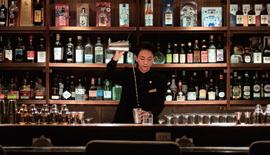
Please drink responsibly
No. 1, Sec. 4, Zhongshan N. Rd., Zhongshan District, Taipei City ( 台北市中山區中山北路四段一號)
Tel: (02) 2886-8888 Fax: (02) 2885-2885 www.grand-hotel.org

Taipei City
一季戶味
Located in Taipei's Minsheng Community, A Honed Dumpling specializes in authentic home cuisine from Yantai in China’s Shandong Province. Owner Li Changqing handmakes seasonal dumplings using fresh, seasonal fish and vegetables – mackerel in winter, shepherd's purse in spring... These authentic Shandong flavors are rarely found in Taiwan, and you can also experience the natural flavors of the island’s four seasons. Because the menu is highly seasonal, every visit offers a surprise, making this eatery a mustvisit for travelers seeking freshness and unique flavor.
No. 525, Fujin St., Songshan Dist., Taipei City ( 台北市松山區富錦街525號)
Tel: (02) 2761-6223
www.facebook.com/1hudumpling
太平茶聚 • 共好聯盟


Woosa offers an all-day Japanese-Western dining experience, featuring creative dishes such as Chazuke Risotto, Omurice with Curry, Pasta, and Japanese Hamburger Steak. A true highlight is the signature Cloud Pancake, a one-of-a-kind creation from Taiwan. Crafted with premium Japanese ingredients and the freshest local produce, these pancakes are celebrated for their incredibly soft, fluffy texture that melts in your mouth.
At Woosa, we blend the charm of JapaneseWestern comfort food with the joy of our Cloud Pancakes—turning everyday meals into moments of happiness.


Shop 1012, No. 159, Chunde Rd., Zhongli Dist., Taoyuan City (Gloria Outlets Branch) (桃園市中壢區春德路159號1012店鋪/Woosa洋食鬆餅屋桃園華泰店)
Tel: (03) 287-7026
Hours: Mon-Thu 11am-9pm; Fri-Sun until 10pm

Taipei City
Known as one of Taipei's most beautiful old-house restaurants, Leputing has a strong reputation. The Japanese-style building, formerly a dormitory in the city's Nishiki-Cho neighborhood, was built around 1922 for mid-to-high-level officials. Maintaining the original structure, the restaurant blends gastronomy, scenery, and art to create a cultural hub and urban oasis. A renowned Japanese garden master was hired to craft a serene landscape. The menu features a unique fusion of French cooking techniques and Japanese seasoning, inviting guests to enjoy seasonal delicacies within the architecture's seamless blend of old and new.
No. 67, Sec. 2, Hangzhou S. Rd., Da’an Dist., Taipei City ( 台北市大安區杭州南路二段67號)
Tel: (02) 2395-1689



Taipei City
Want to experience a truly authentic tea journey? Join the Chiayi Taiping Tea "Bamboo Tube Tea Roasting Mini-Tour!" Fill Jinxuan tea leaves into a bamboo tube, then slowly roast them over charcoal. The bamboo's fresh aroma will infuse with the tea, creating a unique brew. This trip includes a guided tea plantation tour, a DIY bamboo tube tea roasting activity, a pastry DIY session, and tasting local coffee from the four Taiping villages, allowing you to enjoy the aromas of tea, bamboo, and coffee all at once. It's a completely relaxing experience with cute cats and dogs as companions. Afterwards, you can visit the Taiping Suspension Bridge and the Old Street, creating lasting memories of this charming mountain town. Participants: Min. 4 persons, max. 25. (English guide available)


No. 22, Xizhouzi, Wenfeng Village, Zhuqi Township, Chiayi County (Jin Yun Sin Tea Park)
( 嘉義縣竹崎鄉文峰村溪州仔22號(晉揚欣茶庄&咖啡莊園))
Tel: 0919-167007
www.facebook.com/profile.php?id=61578033369239

蘇杭點心店
Featuring a perfect 18 folds, the soup dumplings (xiaolongbao) at Su-Hang Snack Shop are filled with pork hind leg and chicken bone broth, offering a rich and mellow taste with every bite. The pork chop is quickly seared in a sauce to release its aromatic fragrance before being added to yardlong beans, resulting in the incredibly satisfying Ningbo Pork Chop Fried Rice. You can also try a bowl of Oil Tofu Vermicelli, featuring a broth made with only authentic ingredients. Politicians, celebrities, and travelers have sought this famous spot for half a century, with patrons now welcomed by the clear, warm greeting of the second-generation owner. Carefully guarding the refinement and spirit of Jiangsu and Zhejiang cuisine, the Su-Hang Snack Shop demonstrates that these excellent flavors are the result of fastidiousness and patience.
No. 14, Sec. 2, Roosevelt Rd., Zhongzheng Dist., Taipei City ( 台北市中正區羅斯福路二段14號) Tel: (02) 2394-3725 www.facebook.com/100064132505737





435th in World Rankings (QS World University Rankings 2026)
3 3rd in International Outlook among Taiwanese universities (Times Higher Education 2024)
7th in Education and Educational Research (Best Global Universities 2024) Top 100
Top 100 in QS World University Ranking by Subject: Education and Training, Library and Information Management, Linguistics, and Modern Languages
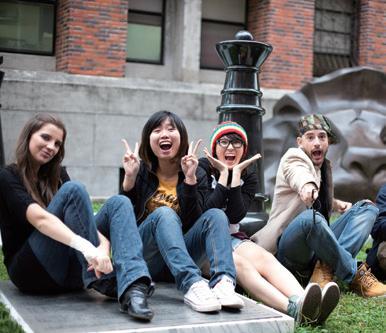
2026 First Round: November 3-December 15, 2025 February 2026 September 2026 Second Round: January 12-March 3, 2026 May 2026
• For the specific application schedule, please refer to the admission prospectus of the year.
• Online application only. Please refer to International Students Application website for details: https://bds.oia.ntnu.edu.tw/bds/apply
38th in Education (Times Higher Education 2024) Popular and Recommended Departments/Institutes for International Students
430+ partner institutions around the world
key cultivation university in the Bilingual Education Program in Taiwan
The world-renowned Mandarin Training Center
Application Information, YouTube, and Instagram



Studies and Social Sciences
2. Full tuition waiver (Bachelor’s program: 1 year; Master’s program: 2 years; doctoral program: 3 years) Scholarships
1. Taiwan Scholarship (please contact the nearest diplomatic missions in your home countries)